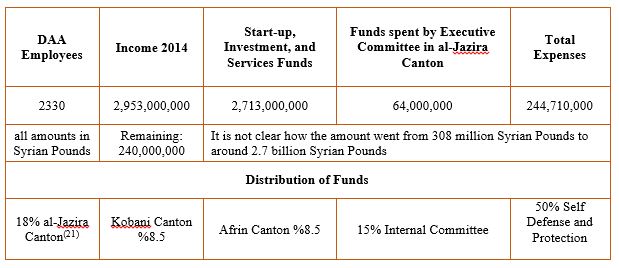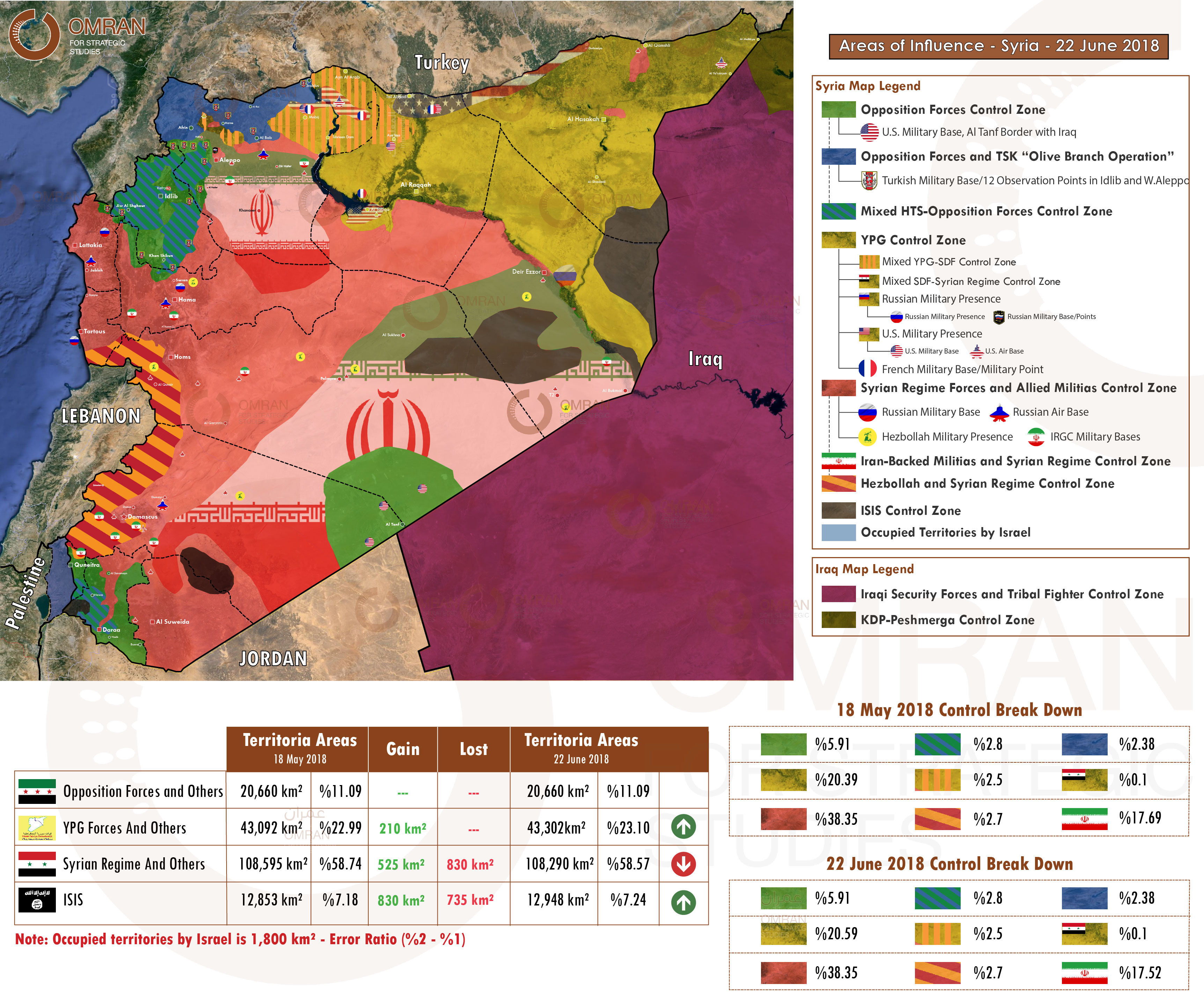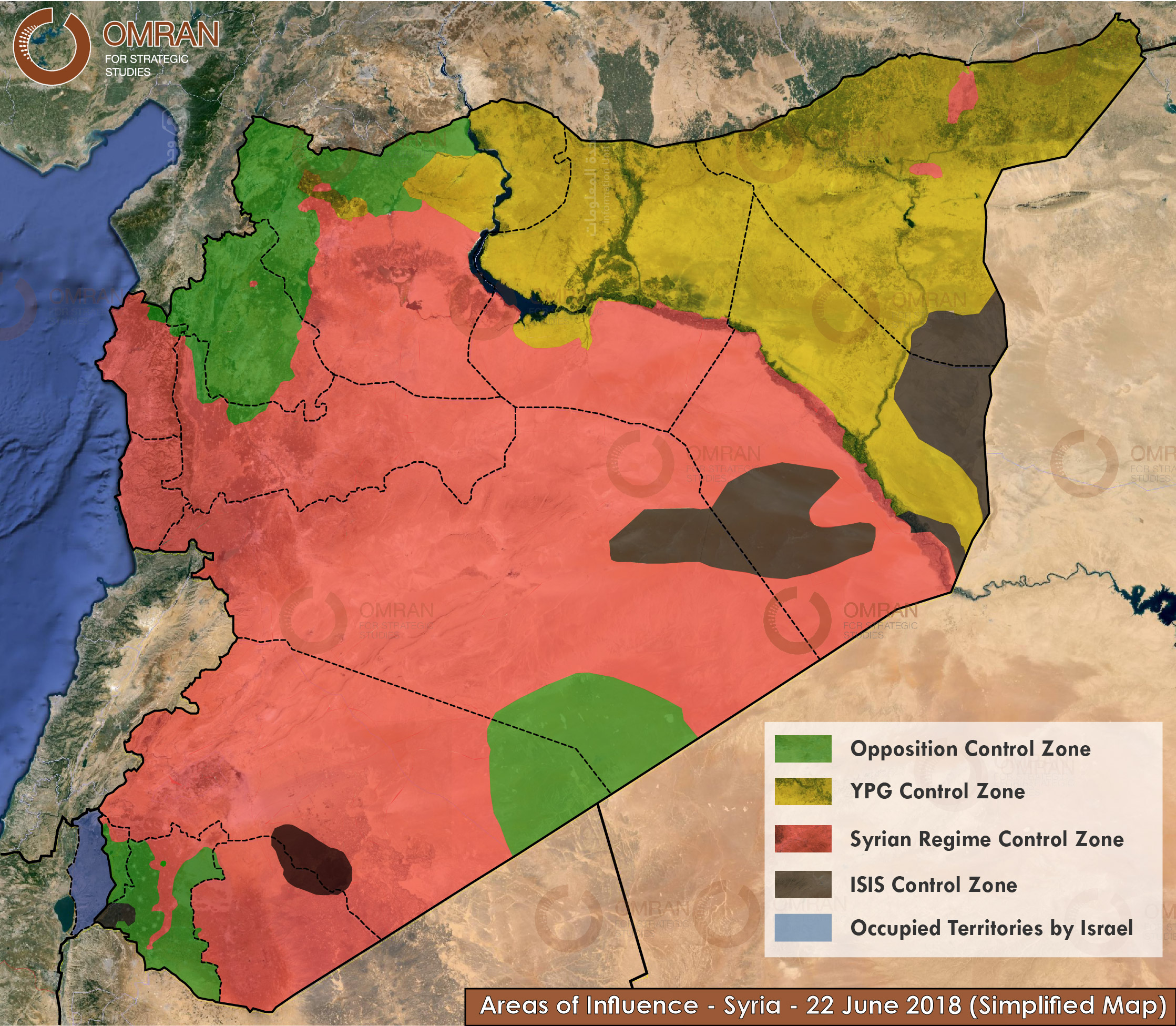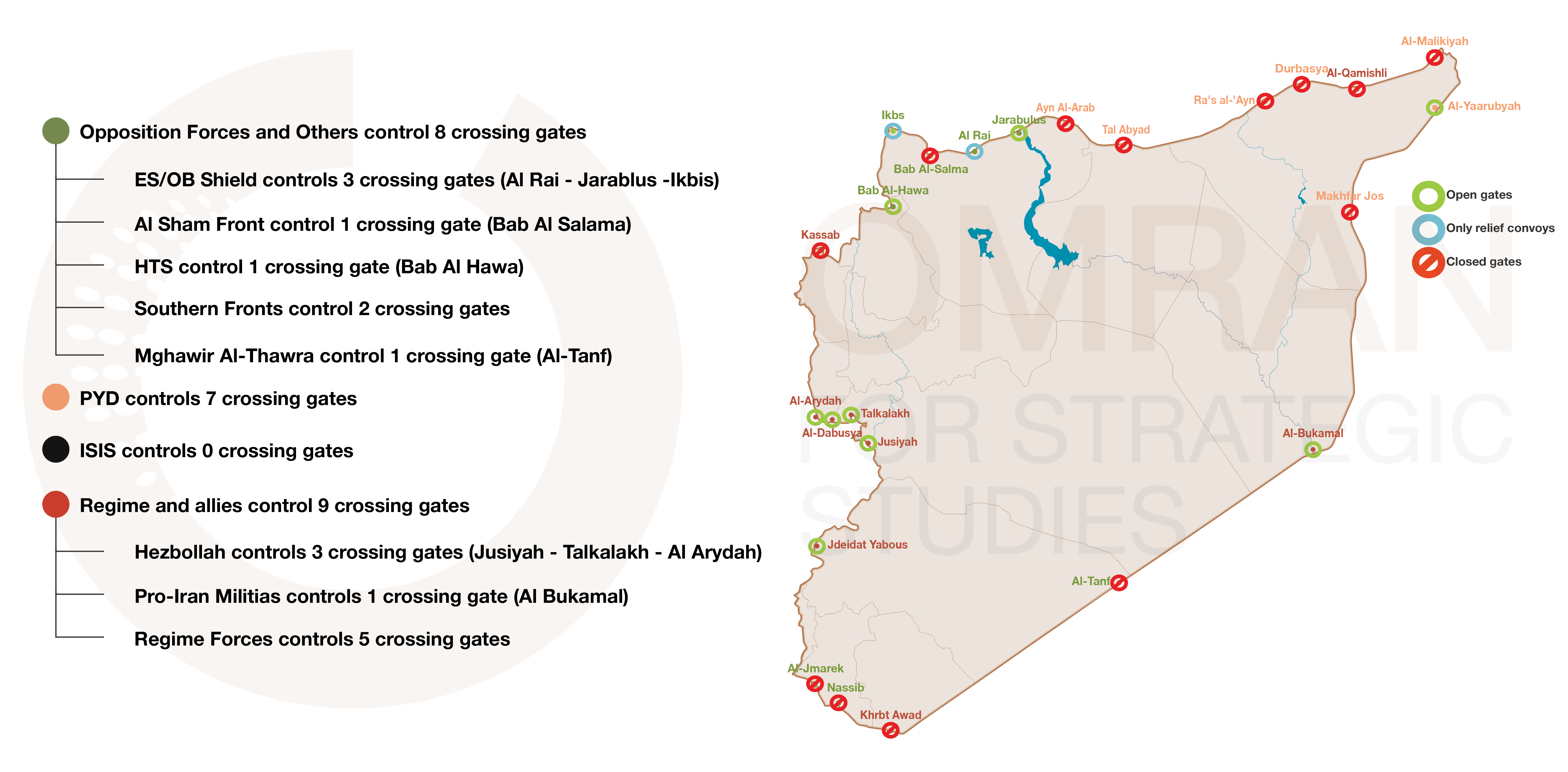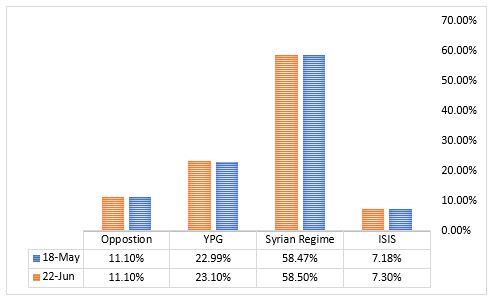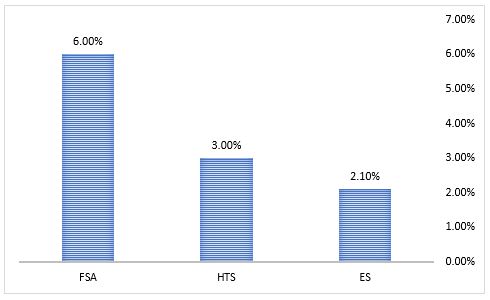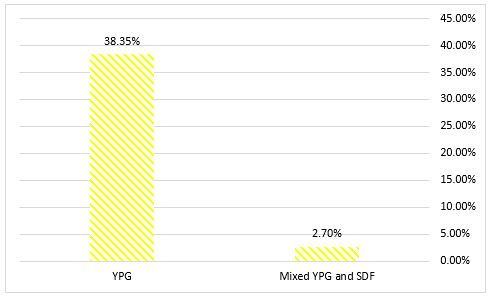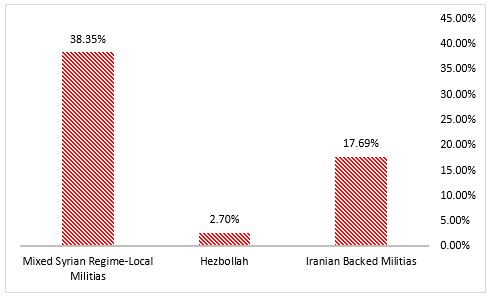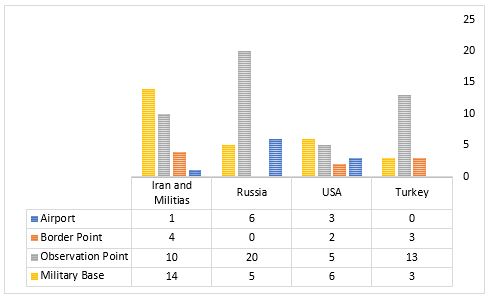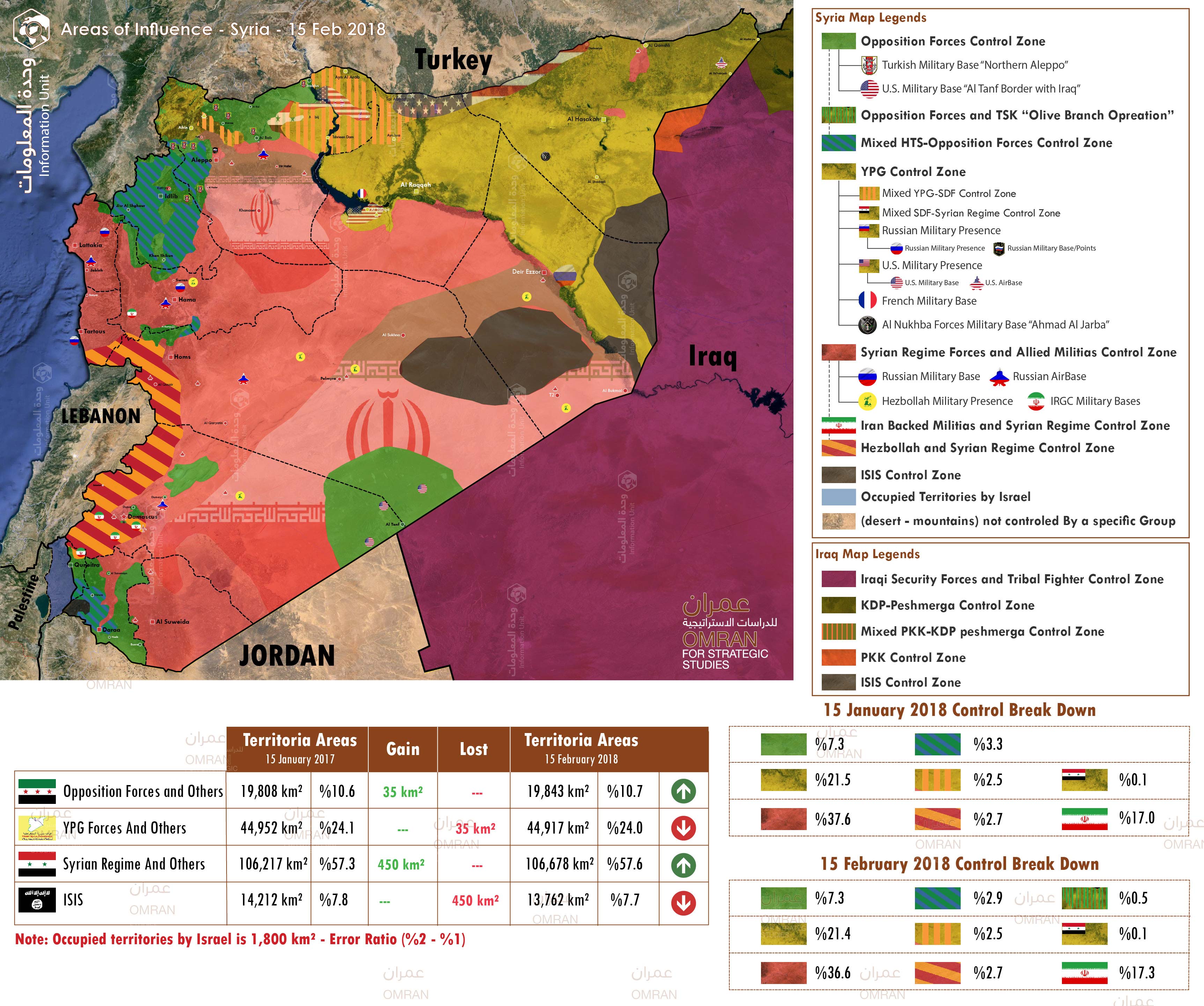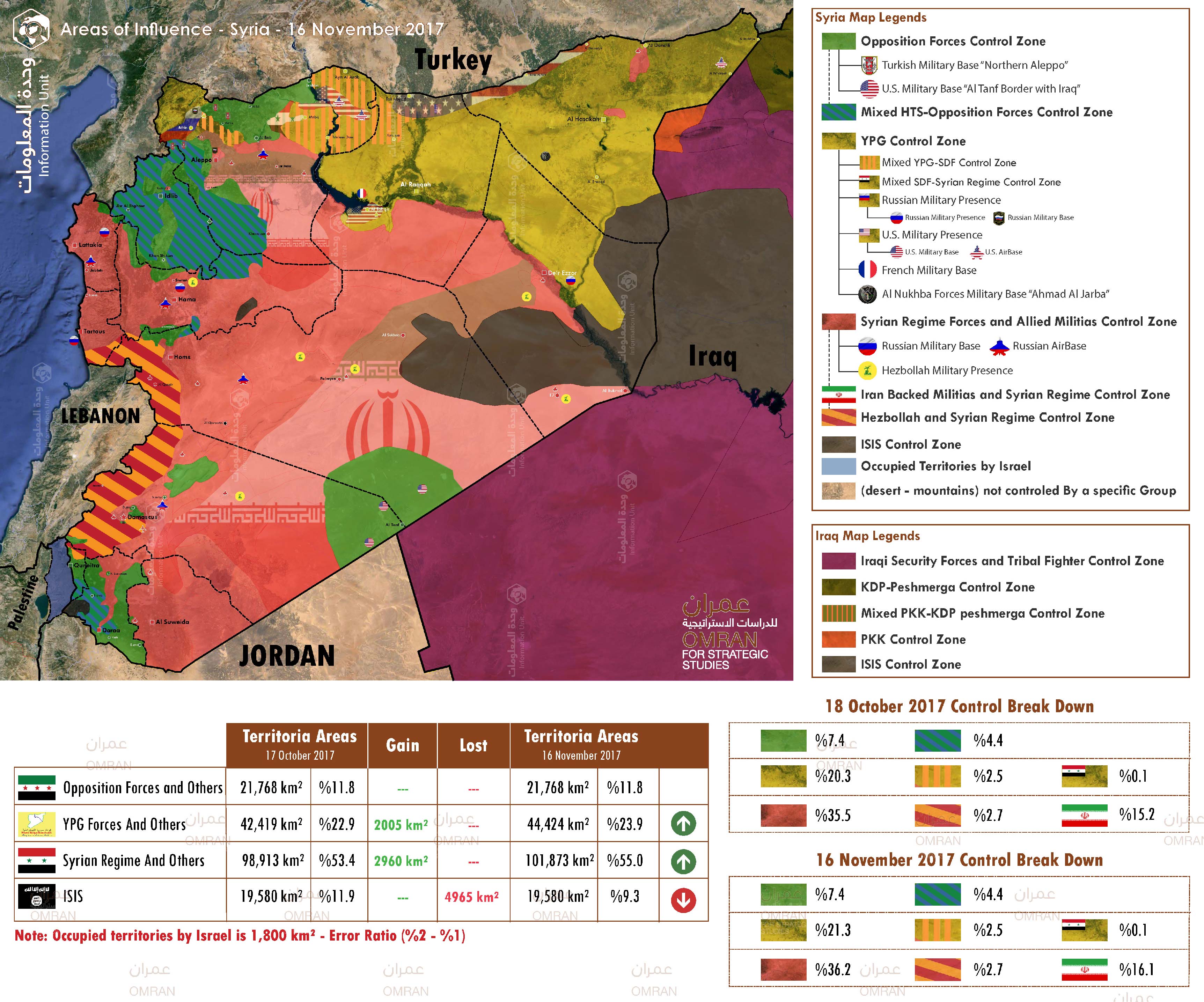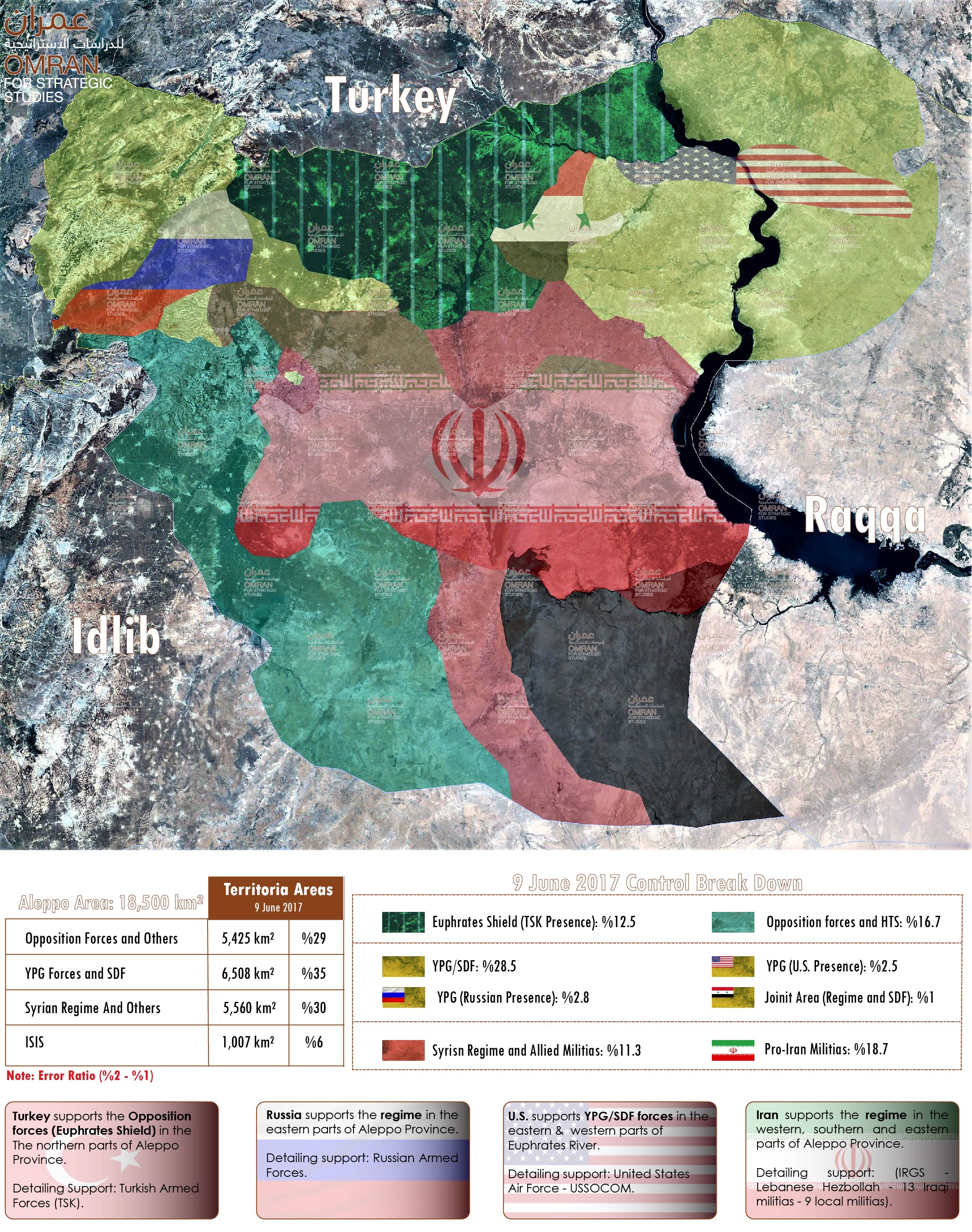Media Appearance
Navvar Shaban | What can be achieved by the US Turkey joint patrols near Manbij
On the 09 th of November, Omran Dirasat military expert Navvar Shaban participated in TRT strait Talk show talking about:Turkey has stepped up its attacks on YPG targets in northern Syria, while also conducting joint patrols with the US in areas where the terror group operates.
The Autonomous Administration in Northern Syria: Questions of Legitimacy and Identity
Executive Summary
- The Democratic Autonomous Administration (DAA) project faces a number of challenges, including repeated failed attempts at gaining legitimacy and recognition by different actors within the Syrian conflict. Despite the success of the DAA’s military wing—the People’s Protection Units (YPG)—in fighting the so-called Islamic State group (ISIS) and becoming America’s main ally on the ground for the international coalition; their alliance with the US did not gain them additional political recognition. Nor did it protect them from parties to the conflict such as Turkey that view their project as a major threat, in response to which it launched Operation Olive Branch. The Assad regime in Damascus also views them as a threat to its national sovereignty and threatened to wage a non-stop war on areas under control of the Syrian Democratic Forces (SDF), and to push for public uprising and protests against them in Raqqa, Manbij, and Hasaka.
- The DAA has been unable to garner support from the local communities under its control, both Arab and Kurdish populations, for a number of reasons including their lack of a clear identity. On one hand, the DAA is “Kurdish-centric when needed,” and on the other hand, it preaches a “Democratic Nation Theory” that transcends ethnicity and religion. This is reflected in the “Social Contract,” it imposes, which contains some concepts that can be regarded as general Syrian demands after years of war and killing, such as the idea of strengthening local governance and decentralizing power. But at the same time the “Social Contract” details a number of concepts that overstep central state authority, and alter local social norms and practices based on a partisan ideological background.
- Difficulties in implementing the “Social Contract” and a new political program in different geographical regions of Syria with a variety of ethnic, cultural, and religious identities, resulted in a number of conflicts within the SDF alliance on several occasions.([1]) Furthermore, the Democratic Union Party (PYD) was unable to convince the majority of the Kurdish public to adopt the DAA project either. Despite their security grip on the DAA areas, there have been several protests held by the Kurdish National Council (KNC), criticizing various issues such as the forced implementation of Kurdish as the only language used in schools in Kurdish majority areas.
- In terms of resource management, the DAA’s governance suffers a lack of transparency with respect to its mechanisms for managing institutional income expenditures. DAA’s assets are administered by the Executive Committee of the cantons, which act in place of typical government ministries and operate independently. Despite the relative stability in large areas under DAA control, they have not successfully achieved a level of administration that is proportionate to the amount of resources and assets available to them.
- Despite having characteristics of a functioning governance system, the DAA still suffers from a number of key deficiencies, notably: a lack of transparency and clarity, the absence of a clear strategic plan or set of policies, the marginalization of civil society, a lack of bureaucratic and technocratic expertise.
Introduction
The Syrian Revolution created conditions that allowed non-state actors to emerge across the Syrian map including the Democratic Union Party (PYD) and its umbrella, the Movement for a Democratic Society (TEV-DEM), which together along with other smaller parties established the Democratic Autonomous Administration (DAA). From mid-2012 until present day, the PYD tried to keep feet in both camps (to remain neutral – supporting neither the regime nor the opposition) while working to strengthen its own project. The DAA project went through a number of phases, from times of relative stability to times like the battle for Kobani in January 2015. They continued to gain power and territory until Turkey launched Operation Olive Branch, which resulted in the DAA losing Afrin, one of its most critical cantons.
During the development of the DAA, challenges arose at the political, legal, executive, and administrative levels, operations and take away from its legitimacy to govern. These issues are explained at length in this analytical paper.
The DAA: Acceptance and Recognition
The DAA originated—and emerged from its dominant group, the PYD—in a political and social context in which people were looking to undermine the legitimacy of the Assad regime in all its forms. The main political force, the Democratic Union Party (PYD as a party formed at 2004), comes from within the DAA itself. They existed in a political reality in which people were looking to discredit any legitimacy for the Assad regime. The DAA failed to get any guarantees during its fight against ISIS that would safeguard its political gains afterwards. Despite the PYD’s extensive efforts to stabilize its project, the DAA still suffers from a lack of recognition from key actors: first from a large slice of its primary constituency the Kurds; second, from the Assad regime; and finally, Syrian opposition groups differ in their evaluation of the DAA, some because of their differing standards of local administration and others due to their regional alliances.
There are three identifiable sources of legitimacy in Syria today: the Syrian people and their cultural and political activity; the regime, due to the international community’s continued recognition of the Assad government as the Syrian state; and the Syrian opposition due to the international community’s recognition of its coalition institutions. The DAA will continue to suffer from a lack of legitimacy if it does not secure recognition from one or all of these sources.
On a local “Kurdish” level, the DAA’s legitimacy is contingent on a number of factors, the most important of which is the success of its security operations in keeping armed conflict out of urban areas under its control. Other factors include its success in the fight against terrorism, and its ability to delay Turkish intervention deeper into DAA territory. The DAA has been able to effectively use these issues in developing its political narrative, often exploiting developments in the situation of Kurds in Iraq and Turkey. For example, the PYD used the fighting against Turkish army in Kurdish populated Turkish cities in 2016 to spread fear among the public by broadcasting details of the fighting through the DAA’s media channels. Promoting an “external threat against the Kurds” narrative in its political rhetoric has been a key strategy for the DAA since it first took control of territory in northern Syria. The fear of instability is one of the most important reasons that the population continues to overlook other practices, in some cases human rights violations, by the DAA.
With the end of ISIS’s military power in sight, there is a growing need for the DAA to gain legitimacy in a the eyes of much larger cohort of non-Kurdish Syrians, especially after taking control of places like Raqqa and rural Deir Ezzor. The events of Manbij City, with increasing calls for protest against “Kurdish” control of the city, have revealed the size of the imbalance between security and local support. Recent assassination attempts in Manbij targeting the DAA’s civil and military leaders, including members of the US-led international coalition, highlight the local population’s low tolerance for DAA practices.([2]) It is worth noting that the regime has tried to capitalize on these negative sentiments towards the DAA and reintroduce itself as the legitimate governance structure northeast of the Euphrates River. The regime has funded and supported Hussam Katerji, a local businessman and Member of the People’s Assembly, to form the so-called “Popular Resistance in Raqqa,” with the stated goal of ending what it refers to as the American occupation. The group has called on locals in Raqqa to protest in support of Assad and to demand that the Syrian Democratic Forces (SDF) and others coordinating with the US-led international coalition leave the city.([3])
Internationally, the PYD has worked hard to gain recognition from three key stakeholders: Russia, the United States, and some EU member states. The PYD traditionally enjoyed strong ties with Moscow due to the historic relationship between the Kurdistan Worker’s Party (PKK) and the Soviet Union, but made recent efforts to get closer to Washington for a number of reasons. The most important of these was to hinder a Turkish intervention, especially as they approached the brink of armed confrontation with the Turkish military. The PYD’s relationship with the US began during the siege of Kobani, and later developed into a partnership on the ground fighting ISIS. The People’s Protection Units (YPG) succeeded in convincing the Pentagon to depend on them exclusively by quickly adapting to America’s regional priorities. This was facilitated by the Syrian opposition’s insistence on fighting both the Assad regime and ISIS simultaneously, an approach that Washington rejected, arguing that it did not want to be distracted from critical anti-terror operations.
The US Department of Defense (DoD) was eager to work with the YPG, but put pressure on them to merge into a new group called the Syrian Democratic Forces (SDF) in order to avoid potential legal issues due to the designation of PKK as a terrorist organization by the US. The SDF’s literature does not refer to any ideological affiliation with the PKK and does not preclude Arabs or other non-Kurdish people from joining. Instead, the SDF actually encouraged Arab armed groups to join them in full, with their fighters and equipment, in order to show their ethnic and political diversity makeup of the new formation at the behest of the Americans. Regardless, the new group and its all of its subsequent mergers maintained a framework dominated by the YPG, which controls all decision-making mechanisms and power structures within the SDF.
Despite the flexibility towards the American demands demonstrated by the PYD’s leadership in Qandil ( The PKK has bases in the Qandil mountain area of Iraq([4])) and at the local level in Syria, their relationship with Washington remained limited to military cooperation between the SDF and the international coalition, without translating to any sort of political recognition. Instead, the Americans put significant political pressure on the PYD leadership to break ties with Qandil. This culminated in the creation of the new “Future Syria” party as an ideological partner to the SDF without direct connection to the PKK or related institutions.
The lack of US political recognition of the DAA in Syria pushed it to keep some remnants of positive relations with both Tehran and Damascus, and to maintain their historic relations with Moscow. Russia recognized the DAA’s interests in pursuing relations with Russia despite its military coordination with the US. The DAA’s relations with the US did not deter Russia from using the DAA to serve its own political agenda in Syria. Russia allowed the DAA to open a representative office in Moscow, and invited the group to participate in international forums and negotiations for a peaceful political solution. Russia also used its unique relationship with the DAA to put pressure on both Turkey and the United States at certain times of the conflict. Russian political recognition of the DAA was coupled with security cooperation after Russia’s military intervention in Syria. They supported YPG offensives to take control of Tel Rif’at, Menagh Airbase, and other villages in northern Aleppo, and sent Russian military detachments to serve as a buffer zone in Afrin. Ultimately, Russian interests came to align more closely with Turkish security priorities, especially in Operation Euphrates Shield and Operation Olive Branch, which were both results of military and security arrangements made during the Astana process.
The DAA’s relationship with EU member states offered them opportunities to open political missions in a number of European capitals including Brussels, Stockholm, Paris, and Berlin. These missions do not have official political recognition from their host countries and their legal presence is limited to registration as non-governmental organizations. However, these missions are directly managed and operated by PYD representatives.
As described above, despite its political and military maneuvering, the DAA was unable to overcome the obstacle it faces in gaining societal, national, and international acceptance and recognition. In reality, its activities did not extend beyond portraying a façade of a formal structure with little space for local participation. On a national level, the two sides of the conflict—both the regime and the opposition—have hostile relations with the DAA until today. On an international level, the changing political context and its impact on the political process means that behavioral shifts are a key characteristic of the actors. For this reason, any legitimacy or recognition the DAA attains is temporary and could change at any moment.
A Social Contract in a Fluid Political and Military Context
A group of parties affiliated with TEV-DEM, and several other related organizations, together announced the formation of the DAA on January 21, 2014.([5]) The announcement followed a series of failed meetings and attempts to form the Council of Western Kurdistan, negotiated in Erbil.([6]) The DAA announced a special social contract, which would act as the foundation of a constitution. Later on, this social contract became the cornerstone of “The Social Contract of the Democratic Federation of Rojava – Northern Syria,” a DAA project that evolved from the Syrian Democratic Council that was formed on October 12, 2015. A draft of the social contract for the federation was circulated June 28, 2016 in the city of Malkiyeh. The document was approved by the DAA’s Constituent Assembly on December 29, 2016, under the name “The Social Contract of the Democratic Federation of Northern Syria (DFNS),” after the word “Rojava” was removed from the title. The “Social Contract” document raises a number of challenges related to legitimacy, including questions surrounding the political representation of key actors of northern Syria, issues related to the absence of a capacity to measure popular support, the absence of approval of the “Social Contract” from the Syrian central government or any other government.
The “Social Contract” does not specify the borders of the DFNS. Instead, the text of the preamble refers to a “geographic concept, and political and administrative decentralization within a unified Syria.” The concept of political decentralization is unclear and vague, and the text appears to confuse the concepts of the rights of entities within a confederation —which is more like a union of sovereign states—and federalism, which is a looser term that cannot be defined by one particular model.([7])
Through its new constitution, the DAA granted itself authorities of a central government. In article 22 of the DAA’s “Social Contract”, it not only recognized the right of self-determination, but also appointed itself as the executor of this right without a national agreement with other components in specifically northeast Syria or other parts. Additionally, it contradicts itself when it recognizes the sovereignty and territorial integrity of Syria and at the same time unilaterally declares the right of self-determination to all groups and components of Syria. Articles 54 to 84 describe the governance structures and institutions of the DFNS starting with the smallest structure—the commune—all the way to the committees and executive councils of the cantons, as well as the executive council of the DFNS. The same articles explain how the councils and committees are formed, including the election commission and the defense council. The Executive Committees of the cantons includes 16 offices and the Executive Committee of the DFNS has 18 general councils. The total number reaches 33 executive bodies without taking into account the neighborhood councils. Despite the fact that the “Social Contract” stresses principles of democracy and freedom, it created a fertile ground for local dictatorship and a crippling bureaucracy by obligating all citizens to serve in at least one neighborhood commune office.
Article 66 states that “every region can develop and strengthen its own diplomatic, economic, social, and cultural relations with the neighboring people and countries, provided they do not contradict with the ‘Social Contract’ of the DFNS or with the Syrian state.”([8]) Yet, the DAA has itself opened offices and developed relationships, including the opening of foreign missions, as an effort to secure its political interests. Interestingly, hosting foreign militaries in a territory is an act usually undertaken by a formal state, and is therefore incompatible with Article 66. In response to such criticisms, the Co-President of the Council of the Federation of Northern Syria, Hadia Yousef, said during a presentation at the Kurdish Center in Egypt on July 20, 2016 that:
- The federal system detailed in the document does not call for the division of or separation of northern Syria, instead we accept to live in a state that protects the rights of the people who live in it.
- Federalism is the only solution to the Syrian issue, and if they desired to separate, they would have already done so.
- Defense and foreign policy will be managed by the central power.([9])
The “Social Contract” of the Federation of Northern Syria faces a number of complex challenges, especially as it expands. There continues to be a lack of representation of the KNC as well as the residents of Raqqa, Manbij, southern rural Hasaka, and Shadadi, all cities that have a majority Arab ethnic makeup. There is also the issue of unilaterally adopting the federal model without consulting other political components in the country, and doing so during a period of political and military fluidity and with increased regional and international intervention.([10])
Administration of Social and Geographic Diversity
Since the start of the Syrian revolution, the PYD (DAA) controlled different and diverse geographic territory in which people from a variety of backgrounds live. Between 2012 and 2015, they had control of 12% of Syrian territory including Afrin, Kobani, and two thirds of Hasaka province.
The area of Afrin, located in the larger Akrad Mountains region,([11]) has plentiful fresh water, fertile mountainous terrain, and strong olive and textiles manufacturing and trade industries. Most of the area’s residents are Kurdish and unaffiliated with tribes. Al-Jazira and Kobani on the other hand, lie on flat plains and are known for their dependence on wheat and cotton cultivation. These two regions suffered from marginalization by the Assad regime as well as a stifling of the private sector. The main cities there are also relatively young, founded at the turn of the last century after demarcation of the current borders between Syria and Turkey.([12])
In addition to the impacts of economic and commercial activity on the social structure and ideological orientation of the cantons, there are other social and political differences within the DAA areas. For example, Afrin’s close proximity to Aleppo is one of the reasons that it had a strong manufacturing sector and an abundance of factories. The manufacturing and commerce-based social structures of Aleppo have also had an influence on Afrin, helping create more stable social dynamics than in the al-Jazira and Kobani regions, which depend more on seasonal crops. The level of attachment to a specific geography is dependent on natural factors. For example, olive trees in Afrin are hundreds of years old, whereas al-Jazira and Kobani were pastoral lands for the inhabitants of nearby cities just 100 years ago – with the exception of historic cities like Amude and Malkiyeh. For the reasons, settlement patterns east of the Euphrates River are different from Afrin. For example, one of the main reasons for the migration of 1.5 million people from al-Jazira to Aleppo and Damascus between 2006 and 2008 was the lack of rainfall.
The diverse make up of these three regions (al-Jazira, Kobani, and Afrin) also affects the political and partisan identities there, as a result of several factors. First, they are influenced by significant Arab cities nearby. Despite high numbers of Kurdish residents in Kobani and Afrin compared to northern al-Jazira, Kurdish nationalism first appeared in full force in Hasaka province in response to the Baath Party’s nationalistic and exploitative policies. Looking closely at the geographic distribution of the political forces in Malkiyeh near the Iraqi border in the east, all the way west to Afrin on the Syrian-Turkish border, it is clear that there are large differences even among the Kurdish political factions themselves. The strongest grassroots support for the Iraqi Kurdistan National Party (KDP) is concentrated in the east, and the PKK’s support base gets stronger towards the west, culminating in their strongest bastion of support in Afrin. Furthermore, the residents of al-Jazira still hold strong tribal affiliations, while this practice is less prominent in Afrin and Kobani.
The YPG’s territorial control expanded with the creation of SDF in mid-2015, reaching 24% of Syria’s total territory, more than double the area previously under their control. This increase in territory also significantly increased the number of people as well as the types of cities, towns and villages under the DAA’s control. After having only controlled areas with predominantly Kurdish populations initially, the DAA found itself in control of an area that spread from Kobani in the north, through Raqqa and rural Deir Ezzor, reaching the Iraqi border in the south at Albu Kamal, and from Manbij in the west through Tal Abyad, reaching Malkiyeh in the east. This geographic area is characterized by small Arab cities and towns, vast desert plains, and numerous small hills and villages. The number of inhabitants under the DAA’s control increased from two million to 3.5 million according to some estimates. This also resulted in significantly increased costs related to efforts to protect these territories and people from attacks by ISIS.([13])
The impacts of this geographical expansion on the DAA and its related military and political bodies were not limited to the larger size and higher number of residents. This expansion into southern parts of northern Syria added new Arab elements that the DAA had not dealt with in its initial phase, from 2013 to mid-2015.
The Euphrates River Basin is known to have a large Arab population that still largely retains its tribal traditions. Before the battles for Raqqa and rural Deir Ezzor, the DAA depended on the Kurdish forces as fighters and administrators, and used Kurdish slogans and worldviews to recruit fighters and leaders. This was the most sensitive and volatile issue defining relations between the DAA and the Arab elements coming from a variety of backgrounds and alliances. The Arab tribes in the Euphrates River Valley region in particular have very specific and unique traditions that are unfamiliar to Kurdish members of the DAA. This demographic and social diversity forced the PYD to adopt the idea of a “democratic nation” as a broader worldview in its initial stages, instead of its traditional ethnocentric nationalist worldview. However, this worldview carries with it a number of contradictions to the tribal traditions in the Arab areas, forcing the PYD to constantly reinterpret and redefine their political project according to the orientations of the variety of social groups under their control.
These ideological, political, partisan, and ethnic differences raise the question of the extent to which the idea of a “democratic nation” is influenced by the varied origins of the people living under the DAA. The PYD presented this worldview as a comprehensive solution to achieve justice, equality, and brotherhood for all the people of the east. So what exactly is the “democratic nation,” where did it come from, who suggested it, and how will its problems be solved?
The “democratic nation” as the theoretical basis for the DAA
The “democratic nation” worldview was not created by the DAA. Instead, it is rooted in the evolution of the theory of anarchism by the American thinkers Murray Bookchin and Naom Chomsky. They re-framed anarchism within the existing state structures in a manner that preserves its institutions to avoid total chaos in the absence of governing alternatives. The two thinkers attempted to restrain concepts of anarchism and socialism to recognize the existence and reality of the state in its current framework and then launch its struggle to change this reality away from the workers revolution or the return to natural life.([14])
The PYD describes the “democratic nation” as: “a group of people connected by common ties who practice of democracy to govern themselves.”([15]) Here “democracy” is not used as a governance system and instead as a description for a group of people. This contradicts the Islamic and modern social concepts that adopt religion and nationalism respectively to define the nation’s borders. This understanding is attributable to the socialist and communist rooted traditions of the PKK. After he was arrested, Abdullah Öcalan engaged in revisions to his worldview, and adopted this “democratic nation” concept as a new ideology for his party and followers. In his revisions, Öcalan criticizes previous attempts by himself and the PKK to create a Kurdish state according to modern standards. He developed the concept of the “democratic nation” after an intellectual journey, studying the most significant cultures, religions, and governance structures that existed in the past and today.([16])
The PKK’s members and supporters adopted the “democratic nation” worldview as a roadmap to the “brotherhood of people,” and a key to addressing the problems of the modern nation state. They criticize Marxism and socialism for stopping at dividing society up into competing classes, while its model failed to govern when faced with the capitalist system, which monopolized manufacturing and science and put them under international control in direct violation and oppression of people’s rights. Supporters of the “democratic nation” believe that continued studies and revelations about the shortcomings of past ideologies and philosophies are required in order to develop a new philosophical basis on which to revive critical efforts to deal with the effects of modernization and capitalism.
Öcalan developed the “democratic nation” concept in his early years of captivity. The application of his worldview went into effect in 2003 when alternative local structures emerged to take the place of the central administration of his party. This happened first in order to take the pressure off of his supporters and as a shift away from a Marxist-socialist model towards the model of a “democratic nation.” In terms of application, this approach attempts to enforce the principle of a people’s confederation by shifting central powers away from an authoritarian nationalistic state that gets its legitimacy from external powers. In regard to Kurdistan, its liberation is achieved through the liberation of the Kurdish people. This change does not generate freedom, but rather awareness and revolutionary thinking as the basis of a free society.([17])
Yusuf al-Khaldi, a researcher at the Kurdish Center for Studies, identified two main aspects of the “democratic nation”:
- Local autonomy: This is achieved by allowing local residents to declare their own individual and group identities, with the right to declare themselves as part of a general shared identity capable of representing all the smaller sub-identities as part of the entire nation. Through this reality Kurdish nationalism can transform into an entire nation that shares a semi-independent democratic form.
- General structure: This is achieved by offering widespread freedoms in the diplomatic, legal, social, cultural, and economic sectors within the context of a general state and its borders.
The DAA achieves the principles of semi-democratic independence through two mechanisms:
- An agreement with the nation that controls the modern state apparatus in accordance with a new social contract shared by all aspects and components of society based on their heritage and shared histories in the region, as well as the history of their cultures and relationships.
- The exclusion of any concepts that contain ideas that suggest or refer to policies of integration, dissolution, and exclusion of the other, and complete abandonment of genocidal solutions previously followed by the nation-state which ended in failure. The Kurds should also abandon demands for an independent Kurdish state.
He specifies two ways for the establishment of the “democratic nation”:
- Nationalistic groups should give up their efforts to establish their own states and desire to monopolize the state, and accept a nation state based on semi-democratic independence.
- Kurds should take unilateral steps to move away from trying to establish an ethnocentric nation state and instead adopt the principle of semi-democratic independence.([18])
The philosophical foundations of the “democratic nation” also offer solutions for the problems of women and marriage. According to the theory, the modern capitalist system has failed to understand married life by considering women as the property of men. Instead, the “democratic nation” theory, as opposed to traditional and religious beliefs, views women as productive members of society that are capable of being more productive than men. Addressing women’s problems requires creating a balance in basic tasks and responsibilities in communal life: securing food, safety, and the reproductive process. In the case of the “democratic nation,” the growth of the human population should stop, society must be built between women and men based on "equal life," and gender equality must be fully established.
Resource Management
The reality of the DAA’s rule are further complicated by the lack of transparency of a number of mechanisms related to its resource management and institutional expenditures. The resources available to the DAA are best studied in two phases: the first phase is pre-2015—before they controlled Tal Abyad—and the second phase is from the control of Tal Abyad to present day. Taking control of Tal Abyad brought partial contiguity to the DAA’s territory, connecting the two islands of al-Jazira and Kobani, spanning along the Turkish-Syrian border from Malkiyeh to Manbij. During both phases the nature of the DAA’s resources remained similar:([19])
- Income from public properties: oil and gas in eastern Hasaka province, and grain silos.
- Income from local taxation and customs fees taken at the border crossings.
- Income from service delivery.
- Expats in Iraq and Turkey.
- Local donations.
According to Article 53, paragraph 8, of the DAA’s “Social Contract,” the Legislative Committee is responsible for maintaining the administration’s budget. From mid-2012 to 2018 the DAA has publicly shared its finances only once in 2014 and 2015 as part of discussions between the legislative and the executive committees on March 17, 2015.([20]) It is not possible to ascertain the accuracy of the numbers discussed in those meetings. The two budget reports were criticized by members of the councils due to their reliance on lengthy explanations and lack of specific details on revenues and expenditures. The chart below provides details of the DAA’s budget between 2014 and 2015.
It is important here to mention the lack of transparency in oil production and sales, as well as international grants, and the spending of money meant for reconstruction.
Executive Authority
The DAA's finances are managed by an Executive Committee, which was formed at the beginning of 2014. In reality, Executive Committees function in a manner very similar to how sovereign state institutions -such as Ministry of Foreign Affairs and Defense- operate. It extends its legal mandate from the DAA's “Social Contract” and laws passed by the Legislative Committee. From the start of the DAA, TEV-DEM and the PYD both tried to build the Executive Committee on the basis of alliances, creating a coalition-like structure involving a large number of organizations, including those directly linked to them, or allied groups such as the National Arab Committee and the Assyrian Union Party, and other Kurdish, Arab, and Assyrian groups. The PYD tried to monopolize public opinion through these alliances by insisting on commitment to the concept of the "democratic nation." There are 16 Executive Committees in al-Jazira canton, formed by integrating a number of previously existing offices and committees. A study of these facts reveals that there are efforts to present the administrative structures as complete when there are actually serious deficiencies in cadres and their ability to carry out work on the ground, in proportion to the significant territory that the DAA controls.
The Environment and Municipalities Committee tops the list as the most active body in the DAA. The municipalities are mainly tasked with executing a number of projects through their technical and service departments, including:
- Paving of roads inside the cities and the road connecting rural areas with the cities through anonymous bidding. Several tenders are listed in favor of the Zagros Public Roads and Bridges Company, established in 2013.
- Clearing drainage systems and distributing diesel fuel. Distribution of fuel causes tension with many residents due to feelings of preferential treatment and the small amount of fuel provided.
- Establishing city plans for expanding urban areas under their control. Among these efforts was the planning of an industrial zone in Malkiyeh, aimed at keeping the city clean and free of pollutants. The price of a store in the new area was posted as 2.5 to 3 million Syrian Pounds (USD $5500-$6700) depending on the size. Most of the small to medium manufacturers suffered as a result of this decision because they were forced to relocate their shops that they owned to the new location that was unaffordable.Some local manufacturers claim that some businessmen bought all of the real estate in the industrial zone and they now control the prices.([22])
Through taxation, the municipalities bring in large amounts of money for the different services they provide.([23]) They prepare slaughter lots and markets where livestock can be sold, and they tax storeowners for providing protection, cleaning, sidewalk maintenance, and other services. The municipalities suffer from a lack of skilled workers with expertise in city planning, development, and law. Furthermore, the municipalities do not have branches in the Arab areas under DAA control.
The DAA places additional focus on the Education and Development Committee through the passage of a law to change curriculums. The DAA’s control over the education sector was faced with opposition and disagreements by different components of the local population. There is also the issue of the Assad regime retaining control of the main educational institutions. The DAA influences the educational process by paying teacher salaries as well as training and ideological coaching. The seven years of disconnect from a central government, with little hope of reaching a political solution, allowed the PYD to fill the gap by controlling the content of curriculums taught to children in schools, allowing them to preach the ideals and doctrine of PYD ideology based on the teachings of Abdullah Öcalan.([24])
The DAA’s Health Committee faces the biggest set of hurdles as a result of the war. At the top of their list, they struggle from a lack of qualified medical professionals due to the displacement of doctors outside Syria, and the high costs of securing laboratory and hospital equipment. During the time of ISIS’s siege, there was a shortage in the quality and quantity available in the markets. The Tourism and Antiquities Committee is mainly concerned with preventing destructive activities and artifact smuggling. They also conduct environmental protection and preservation projects. The Arts and Culture Commission struggles to use their local branches, theatres, production and distribution of literature effectively. This commission is responsible for organizing rallies, poems, stories, and books based on the teachings of Abdullah Öcalan, the leader of the PKK.([25]) The Defense Commission is the core of the security and military operations in the DAA. It is working to enforce a mandatory military service rule on everyone born in 1986 or later. Over more than three years, the Commission has taken over 20,000 people into compulsory service.
Despite having characteristics of a functioning governance system, the DAA still suffers from a number of key deficiencies, the most important of which are: transparency, clarity, the lack of a clear strategic plan or set of policies, the marginalization of civil society, and the lack of bureaucratic and technocratic expertise.
Conclusion
A number of factors contributed to the DAA’s ability to extend its control across northern Syria. These include the regime’s retreat from areas with a majority Kurdish population in favor of the PYD and its military wing, the YPG. This created a stable and secure environment in which the PYD was able to strengthen its authority. Following the battle of Kobani, the US-led international coalition also contributed to the DAA’s expansion, helping them take control of 24% of Syrian territory. It had previously controlled less than 10% of Syrian territory before joining the US-led international coalition as their partner in the fight against ISIS in Syria. The PYD’s dominance of the military and security sector compared to the other Kurdish parties also contributed to its ability assert its control over the population. The YPG assisted in this by breaking up the armed groups formed by other Kurdish parties, and enforcing strict policies to ensure that there were no competing forces, using the argument that there could not be two competing Kurdish powers.
The DAA faces a number of legal challenges, the most critical of which is their lack of formal recognition by the central government of Syria or any official national agency. The DAA relies solely on its relationship with the US-led international coalition member states for legitimacy. The second legal issue they face is their vague “Social Contract,” that has many ambiguous and overlapping political concepts. The “Social Contract,” in some cases, contradicts the DAA’s traditional ideological and theoretical foundations. On one hand, the DAA claims that it wants to dispose of the authority of a central government, but in reality, it tied all of aspects of social life with its institutions, and established a monopoly on governance through an intricate bureaucracy of the various communes, councils, and a variety of military formations. The revised the “Social Contract” which proclaims the establishment of “The Democratic Federation of Northern Syria,” presents concepts that are unprecedented in Syrian political history, such as the mixing of pagan and monotheistic concepts thought the use phrases like the “the Mother God” and “I Swear by Allah the Most Great” in the same text. The “Social Contract” was ineffective as a constitution for an autonomous or federal region. Instead, it creates a system that acts more like a confederation since the social contract grants political asylum, builds diplomatic relations, and grants the right to self-determination.
Another issue with the “Social Contract,” is rooted in the DAA’s geographic expansion and unilateral establishment of a so-called “federation,” in the absence of willing and capable partners that represent the large populations like the KNC, and of representatives for places that they have recently taken control of in Raqqa city and the northern part of the province, southern rural Hasaka, and Deir Ezzor countryside. These are majority Arab populations that may reject the legitimacy of a majority Kurdish power structure, and existing local administrative bodies will not be easily convinced to accept such an alliance in their local administration. The most obvious of challenges facing the DAA’s project is the fact that Syria is in a state of constant political and military instability, and regional and international powers still disagree on a format or timeline for political transition in Syria.
The PYD has insisted on adoption of the “democratic nation” concept, and promotes it at a regional level as a solution to the Kurdish question and the problems of other groups. Despite some similarities between their project and the confederation system existing in Europe today, it lacks freedom of application or amendment, because the PYD considers it to be complete and only option. This system also lacks the support of any regional political force. Its policies also conflict with the social reality of eastern Syria, where religion governs many aspects of social life. The philosophy of the “democratic nation” is transnational and cross-border in nature, thus distracting attention away from Kurdish national rights within different countries of the region.
The “Democratic Nation” faces a number of obstacles that have emerged on a local level during its implementation, such as the militarization of society through the formation of groups like the Civilian Defense Forces (HPC), an armed civilian volunteer force responsible for neighborhood security. Furthermore, there are disproportionately large military and security forces compared to the areas and population under the DAA’s control.
The DAA also created a centralized bureaucracy that burdens those managing it. Instead of moving away from the former centralized governing system of the regime, they established a new even more centralized system. Its governing domain expanded significantly and disproportional to the size of the territory and the populating living within it. The DAA also contradicted itself by enforcing a uniform “Social Contract” that does not take into consideration the plural norms and belief systems of the local populations.
Given the size of its control and influence on the Syrian map, if the DAA continues in its current form, it will destroy one of the most important pillars of its political theory: the rejection of modern nation states structures and the borders that create divisions between the people. Instead, the DAA today is responsible for cutting ties between people in the city of Raqqa and its southern countryside, Deir Ezzor and its countryside, and parts of the northern Aleppo countryside.
([1]) See Omran Center for Strategic Studies previous report about internal SDF conflicts, “Military and Security Structures of the Autonomous Administration,” https://goo.gl/MX2dmq
([2]) The international coalition announces the killing of two soldiers after being targeted in Manbij, Source: Northern Syria Observer, Date: 30/03/2018, Link: https://goo.gl/Y1SBN4
([3]) The “Popular Resistance” attacks and American military base in Raqqa, Source: Syria News, Date: 02/04/2018, Link: https://goo.gl/7smXXv
([4]) The Kurdish Qandil Mountains, Source: Stratfor orldview., Date: 28/03/2013, Link: https://goo.gl/J2SGz4
([5]) On the second anniversary of its announcement: Opinions about the Autonomous Administration’s works, Source: Buyer Press, Date: 01/21/2016, Link: https://goo.gl/jp1RhC
([6]) The failure of negotiations between TEV-DEM and KNC occurred for many reasons, notably the conflict between the different regional Kurdish factions supporting the two councils.
([7]) Analysis of the Social Contract of the Northern Federation, Source: Omran Center for Strategic Studies, 08/16/2016, Link: https://goo.gl/6fJedS
([8]) Full text of the “Social Contract of the Democratic Federation of Northern Syria” http://vvanwilgenburg.blogspot.com/2017/03/social-contract-of-democratic.html#!/2017/03/social-contract-of-democratic.html
([9]) Program at Kurdish Center: The video shows experts: The Kurds take apart northern Syria, Source: Masr Al Arabiya, Date: 07/20/2016, Link: https://goo.gl/xKCQGM
([10]) In reference to the subject of identity, it is important to note that nation states emerged in the Middle East following the collapse of the empires of past years. The legacy of this experience was that the locals were unable to create a succinct all-encompassing political identity. For example, the Turkish Republic, which has its roots in the legacy of the Ottoman Empire, is unable to overcome the conception of a single ethnicity and accept that the country is made up a multitude of ethnicities. Similarly, the Islamic Republic of Iran is unable to escape the legacy of the Shah, and cannot clearly identify as Persian nor live in peace in a region that is plagued with plentiful ideological differences. Based on this we can observe that the political structures at the bottom of the governance pyramid in the DAA suffer from the lack of a clear identity. The PYD rejects a Kurdish nationalist identity but at the same time calls for holding a “Kurdistan Conference.” The PYD also denies its core relationship with the PKK, while the success of “Rojava” and the Democratic Autonomous Administration are attributed to Abdullah Öcalan personally, the de facto leader of the PKK. The PYD also compromises its own identity when it is politically convenient. For example, the Syrian Democratic Forces are allied with the capitalist United States, putting the PYD in direct contradiction with the Marxist ideology that it still subscribes to.
([11]) Kurdish presence in northern Syria, Akrad Mountains, Afrin, Source: Madarat Kurd, Date: 04/12/2016 https://goo.gl/7upuYf
([12]) The area of Jabal al-Kurd or the Kurds or Old Kordag is in the northernmost corner of the eastern coast of the Mediterranean Sea. It forms the northwest corner of the Fertile Crescent of the State of Syria, and the heights of the end of the southwest of the Taurus Mountains. The mountains of Jabal al-Kurd begin in the upper reaches of the rivers of Afrin and the west of the city of Gaziantep (Kurdish name Delok) within the Turkish border regions, and are a natural extension of the mountains of Reşa and Zagê of the Kurdish areas in the north and east. The peaks take a northerly northward direction with a slight deviation to the west and a length of about 100 km to its southwestern end, west of the town of Gondirasafrin. Its width ranges between 25 and 45 km. Joining this mountainous region, Mount Lilon and Juma Plain, they have historically formed a single, integrated geographical area along the river valley of Afrin.
([13]) Syria’s population 2018, The numbers are estimates due to the lack of viable partners and resources to collect accurate data, Source: World Population Review, Date: 06/04/2018, Link: https://goo.gl/4uX9bc.
([14]) Janet Biehl, Bookchin, Öcalan, and the Dialectics of Democracy, 2012, http://new-compass.net/articles/bookchin-%C3%B6calan-and-dialectics-democracy
([15]) Dana Jalal, Democratic nation is a new human identity, 2011, http://www.ahewar.org/debat/show.art.asp?aid=258651
([16]) He includes in his arguments explanations of the development of the Sumerian priests and the way to democratic civilization as humans. He treat the Sumerians as if they were the first to establish a "state" in history, followed by the Egyptian, Chinese, Buddhist, Confucian, and Greek civilizations, the birth of monotheistic religions, Islam's dismantling of the slave system, reaching the capitalist civilization and world's general state of identity crisis. He concludes that the concept of the “democratic nation” is inclusive of all previous civilizations with their divine and human characteristics, and that it is a nation of multiple identities, cultures, and political entities in the face of the monsters of the nation-state.
([17]) Sihanouk Dibbbo: Towards a democratic solution to the Kurdish issue; a battle between Ra' and Aviv, Source: Fourth Power, Author: Sihanouk Dibo, Date: 08/29/2016, link: https://goo.gl/JXVxAv
([18]) The Democratic Nation, Source: The Center for Kurdish Studies, Author: Yusuf al Khaldi, Date: 06/23/2016, Link: https://goo.gl/tLRtXo
([19]) Local administration in Kurdish Syrian territories: Afrin as a case study, Source: Omran Center for Strategic Studies, Date: 03/07/2015, Link: https://goo.gl/c5MpXp
([20]) The two councils: Legislative and Executive, discuss the yearly budget for 2015 and the expenses of 2014, Source: Buyer Press, Date: 03/17/2015, Link: https://goo.gl/QLvB7e
([21]) The social contract of the democratic autonomous administration in the al-Jazira canton of Syria was approved during session no. 1 on 01/06/2014, Source: Legislative Committee, Link: https://goo.gl/2bgcde
([22]) The Industrial City project in Derik: Between the Municipalities insistence and the factory owners’ rejections!, Source: Qasyoun Agency, Date: 09/16/2017, Link: https://goo.gl/PmYkaD
([23]) PYD aggression unde the guise of taxation from the people’s pockets to the war chests, Source: NSO, Date: 07/20/2017, Link: https://goo.gl/429A2m
([24]) The state of education in the Autonomous Administration, Source: Omran Center for Strategic Studies, Date: 12/15/2016, Link: https://goo.gl/WRn8YP
([25]) The Fifth Arts and Culture Conference in Rojava, Source: Rojava press, Link: https://goo.gl/Kr8U94
Special Areas of Control and Influence Report June 2018
Updated Influence report and map of Syria 22 June 2018 with % of Gains & Losses in the last 34 Days. Ongoing battles on the Northeast front of Daraa, Regime and allies forces with Russian air support of are trying to control the area to the east of Damascus - Daraa international highway to Nasib crossing gate.
Meanwhile YPG with US support launched a new Military Campaign against ISIS in Southern Hassaka.
Updated Map: Areas of Influence and Control
Map (1): Areas of Influence - Syria - 22 June 2018
Map (2): Areas of Influence - Syria - 22 June 2018 (Simplified Map)
Map (3): Crossing Gate Control Breakdown and Current Situation
Percentage of Control Breakdown
Chart (1): Simplified Percentage of Control (May vs. June) 2018
Note: The charts below show the percentage of total Syrian territory that each faction controls.
Chart (2): Percentage of Syrian Territory Controlled by Opposition Groups
Chart (3): Percentage of Syrian Territory controlled by the YPG
Chart (3): Percentage of Syrian Regime and Allies Control Areas Breakdown
Presence of International Forces
Chart (4): Main International Military Bases and Airports – June 2018
Map of Control and Influence in Syria February 16, 2018
Map of Control and Influence in Syria:
- Turkish Armed Forces (TAF) and the Free Syrian Army (FSA) captured several locations in the western region of Afrin from the YPG/YPJ. Separately, reports emerged claiming that the TAF and the FSA had deployed additional troops and equipment west of the Jandaris district indicating an upcoming offensive.
Pro-YPG sources said that Kurdish forces had repelled Turkish attacks in the districts of Rajo and Bulbul, and claimed that more than 20 Turkish-backed fighters were reportedly killed there.
February 5: A massive Kurdish military convoy entered the Afrin region to support the YPG in its fight against the Turks. As a result, many issues were raised:
- The number of vehicles that left Manbij was 36, but 41 entered Afrin, meaning five extra vehicles joined the convoy from areas controlled by pro-Iran forces.
- After the convoy entered Afrin from a checkpoint in Nubl and Zahraa, areas controlled by pro-Iran forces, multiple Iranian weapons were spotted in the possession of Kurdish forces. Below is a full list of these weapons.
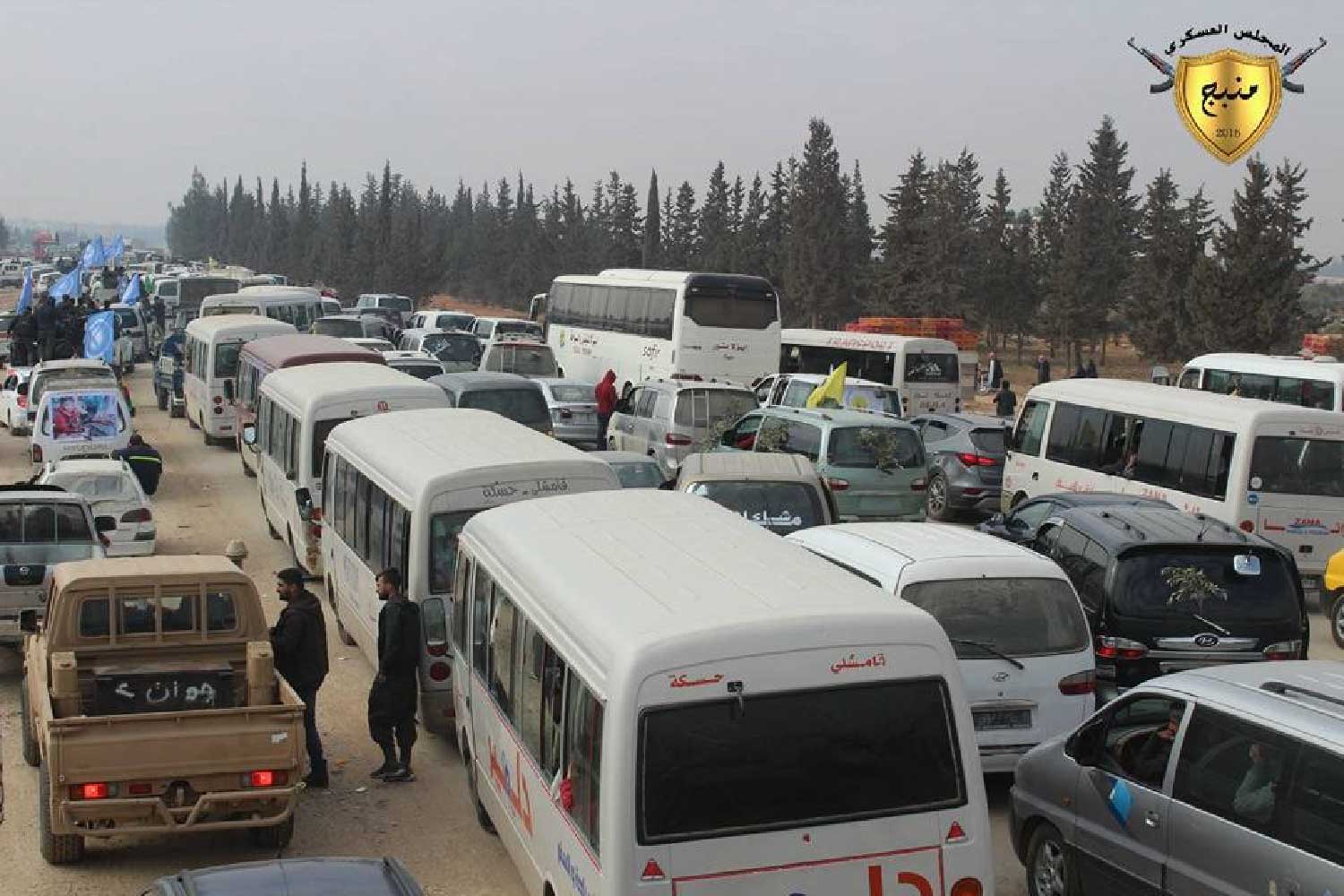
2. Syrian regime and pro-Iran forces, as well as US-backed forces, are reportedly amassing troops and fortifying their positions in the Euphrates region. According to both pro-opposition and pro-government sources, the two sides are preparing for possible skirmishes in the area.
3. February 10: Israeli airstrikes destroyed nearly half of the Syrian regime’s air defenses, according to the Israeli newspaper Haaretz, which cited “senior Israeli Defense Forces officials” in the article on February 14. An Israeli F-16 was shot down during the airstrike; however, Israeli officials considered the operation a success.
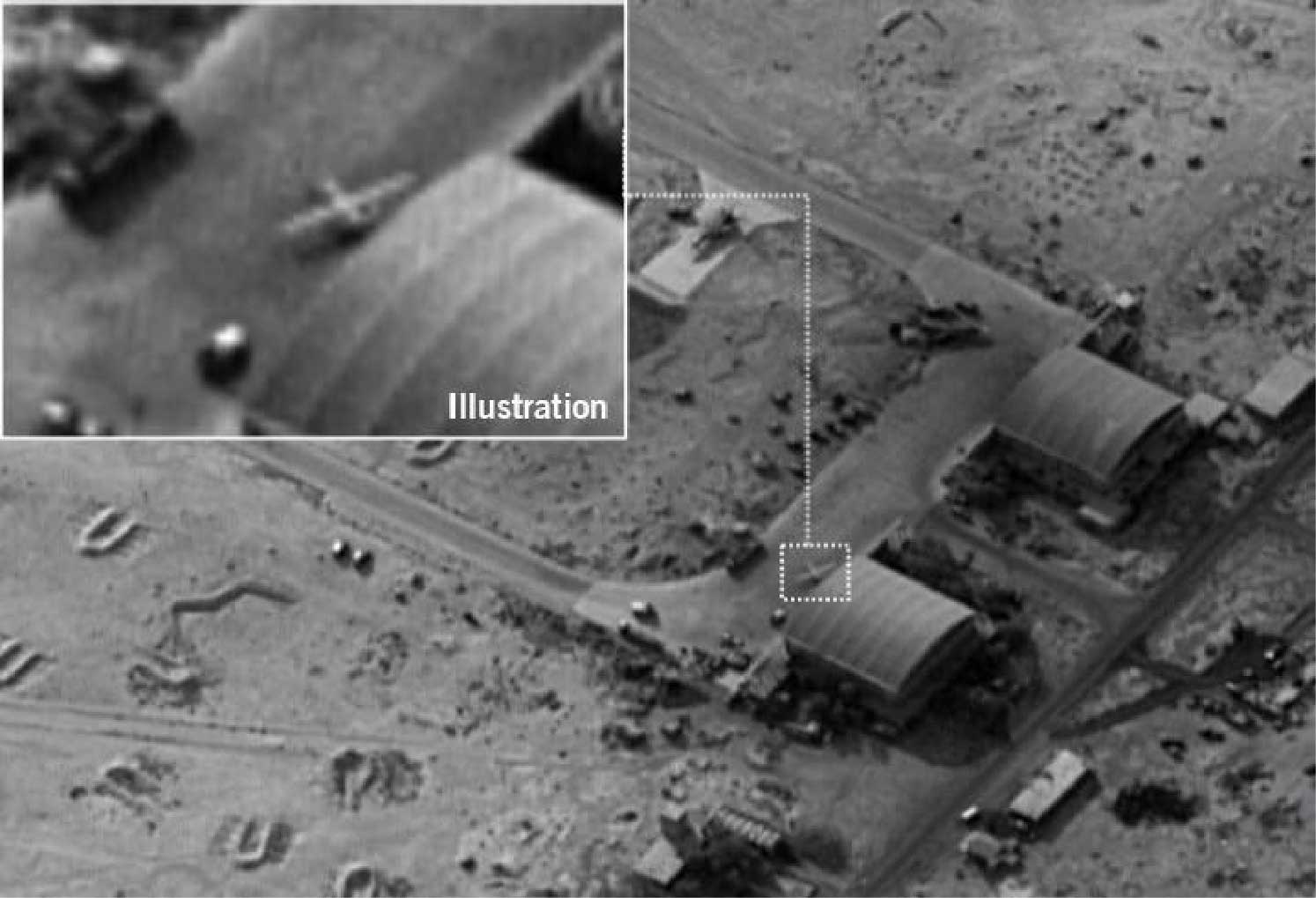
February 12: AnIsraeli military official said that an Iranian drone shot down 10 February 2018, ago was based on a US stealth RQ-170 UAV, which was captured by Iran in 2011. Iran started production of this drone in 2016.
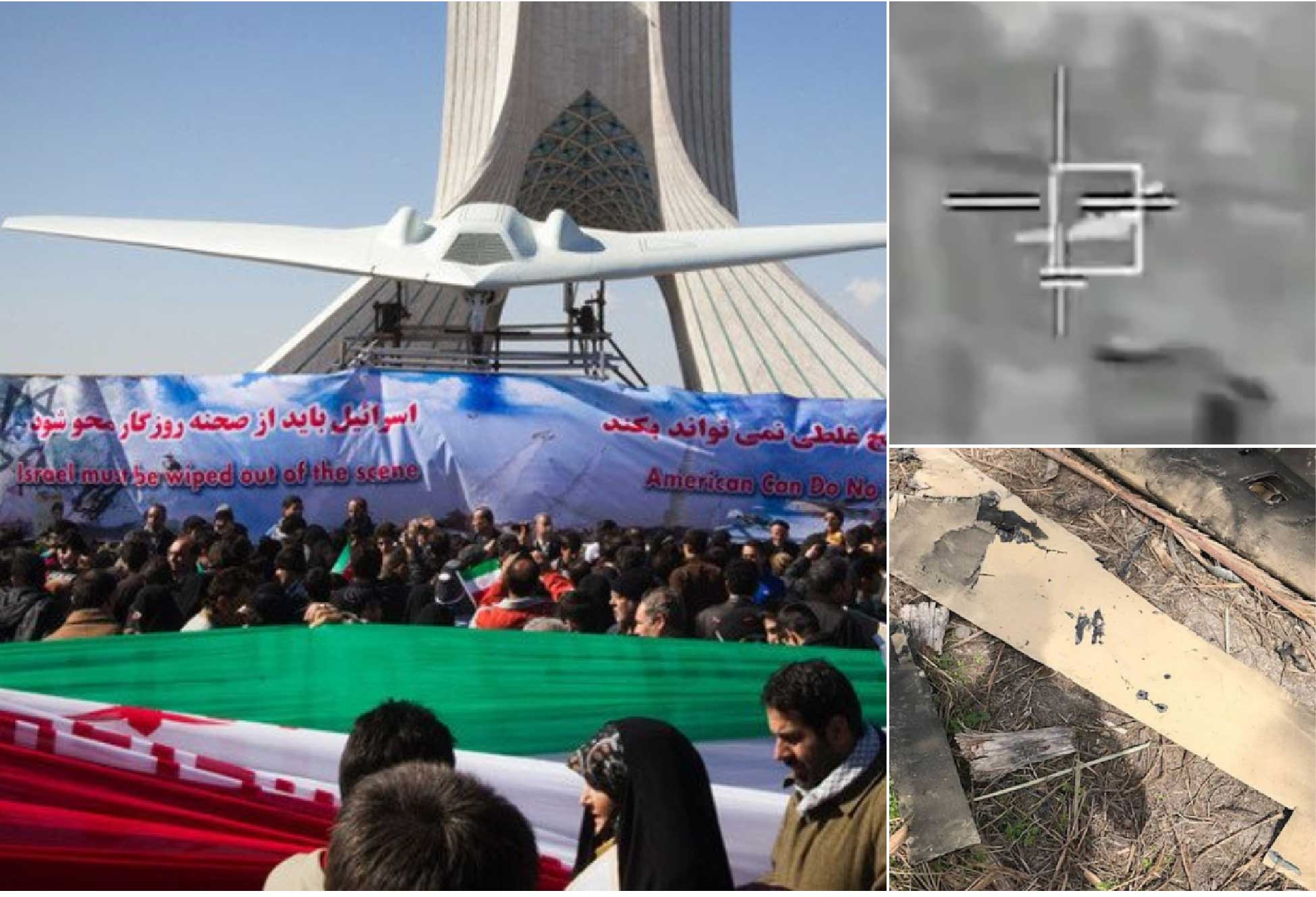
Map of Control and Influence: Syria "16 November 2017"
Damascus
- November 11, unconfirmed reports indicated that Jaish Al-Islam and the Government of Russia reached an agreement stipulating Jaish Al-Islam’s future role as the sole military and political actor in Eastern Ghouta.
- November 12, a UN inter-agency convoy entered Duma city, Duma subdistrict, through Al-Wafideen crossing in coordination with SARC and the ICRC.
- November 15, Ahrar al-Sham launched an attack on the regime forces stationed in the management of vehicles in Harasta, the attack came in response to the regime's repeated attacks on Eastern Ghouta.
Important Note:The humanitarian situation in Eastern Ghouta continues to deteriorate. Bread pack prices reached 1,900 SP, 1kg of rice is currently at 4,000 SP, and most day-to-day essentials are scarce in public markets.
Southern Front
- November 12, Unconfirmed reports suggest the Jordan-based Military Operation Center (MOC) has disbursed its last payment to Southern Front Alliance combatants, as well as its final arms and munitions delivery.
Al Hasakeh
- November 9, SDF established full control over Markada city, in Markada subdistrict, Al Hasakeh governorate.
Important NoteMarkada was considered as the last major city controlled by ISIS in the governorate. Moreover, SDF control over Markada secures its control over the eastern bank of Euphrates River in southern Deir Ez Zor, as well as oil and gas in the area. Nevertheless, reprisal attacks by ISIS combatants remain possible.
- November 12, YPG-led Syrian Democratic Forces (SDF) reportedly handed 52 Russian Chechen individuals, thought to be families of ISIS combatants, to the Government of Russia.
Aleppo
- November 12, Clashes and shelling continued in western rural Aleppo governorate between Noureddine Zinki, a prominent armed group in northern Idlib and northwestern Aleppo, and Hayat Tahrir Al Sham (HTS).
Important Note Clashes reportedly ensued after Hay’at Tahrir Al-Sham attempted to prevent combatants who defected from Hay’at Tahrir Al-Sham from joining Noureddine Zinki in Hayyan and Andan, in Haritan subdistrict, which is controlled by both groups. During the clashes.
- November 13, Syria Regime and aligned forces, allegedly to include Russia, carried out airstrikes on Atareb city, Atareb subdistrict in northwestern Aleppo governorate. Various media sources and local sources have reported casualties at approximately 70 individuals, while several sources reported that at least one airstrike targeted a market in central Atareb city as well as a police station.
Deir Ez Zor/Al Raqqa
- November 8, Syria Regime and Pro-Iran Militias reportedly took control of the Abukamal border crossing, located on the Syria-Iraq border in southeastern Deir Ez Zor governorate.
Important Note as of November 5, Hashd Sha’bi, an Iraqi Hashd Sha’bi militia, took control over Al-Qaim town and its nearby border crossing, opposite Abukamal along the Iraqi-Syria border.
- November 11, SDF reportedly controlled Basira, in Basira subdistrict, and its vicinity, located approximately 32 km south of Deir Ez Zor city.
Important Note 69,047 individuals have been displaced from Abukamal subdistrict to SDF-controlled areas in northern and eastern Syria due to clashes between Syrian Regime forces and ISIS.
Map of Control and Influence: Aleppo Province "9 June 2017"
ISIS and the Strategic Vacuum- The Dilemma of Role Distribution- The Raqqa Model
Executive Summary
- The Raqqa operation closely mirrors the Mosul operation both politically and militarily. Politically, it was launched amid disagreements and a lack of clarity about which local and international forces would participate and who would govern the city post liberation. Militarily, ISIS used the same strategy it used in Mosul aiming to exhaust the attacking forces with the use of improvised explosive devices instead of direct combat. ISIS also retreated from positions near the borders of Raqqa and took more fortified positions inside neighborhoods with narrow streets in an attempt to change the battle into an urban combat nature.
- The battle uncovered critical weaknesses in the Syrian Democratic Forces (SDF) and its ability to fight alone. The SDF required heavy cover fire from Coalition forces as well as direct involvement of American and French forces, which deployed paratroopers in the area and changed the course of the battle by taking control of the Euphrates Dam and Tabqa Military Airport.
- The tense political environment and the various interests of regional and international players will significantly impact the battle for Raqqa and future battles against ISIS in Syria.
- This paper projects four scenarios about how the Raqqa operation and future operations could play out.
- First, the United States’ continued dependence on YPG-dominated SDF forces as its sole partner, which will exacerbate tensions with Turkey.
- Second, a new agreement or arrangement between Turkey and the U.S.
- Third, a new arrangement between Russia and the U.S. in Raqqa, similar to what took place in Manbij.([1])
- Fourth, the latest Astana agreement, which could set the groundwork for the U.S. to open the way for all Astana parties to participate in the Raqqa battle.
- The most important contribution of the U.S. in Syria was undermining the “post-Aleppo status quo”([2]) established by Russia in an attempt to create an environment more consistent with an American policy that is more involved in the Middle East, especially in Syria.
Introduction
On May 18, 2016, the Syrian Democratic Forces (SDF), of which the predominately Kurdish People’s Protection Units (YPG or PYD) form the main fighting force, launched an operation with a few American and French Special Forces and International Coalition air support to take Raqqa from ISIS control. According to the SDF, the battle ended on May 31, 2016, due to fierce resistance by ISIS fighters and the widespread use of mines in the rural areas surrounding Raqqa. At that time, the battle for Manbij was announced. The SDF seized control of Manbij on August 12, 2016, after which the battle for Raqqa was relaunched. In its first three phases, the battle for Raqqa achieved its desired goals: cutting off supply routes and lines of communication between ISIS’s Iraqi and Syrian branches, isolating and besieging Raqqa, and finally preparing for the offensive attack on besieged Raqqa, which is the fourth and final phase of the current operation.
The Raqqa operation closely mirrors the Mosul operation both politically and militarily. Politically, it was launched amid disagreements and a lack of clarity about which local and international forces will participate and who will govern the city post liberation. Militarily, ISIS used the same strategy it used in Mosul aiming to exhaust the attacking forces with the use of improvised explosive devices instead of direct combat. ISIS also retreated from positions near the borders of Raqqa and took more fortified positions inside neighborhoods with narrow streets in an attempt to change the battle into an urban combat nature. Furthermore, the battle uncovered critical weaknesses in the SDF’s ability to carry out the fight alone. The SDF required heavy air support from Coalition forces, as well as direct involvement of American and French forces, which deployed paratroopers in the area and changed the course of the battle by taking control of the Euphrates Dam and Tabqa Military Airport.
This paper analyzes the various political contexts surrounding the battle for Raqqa and breaks down the interests of the local and international actors involved. Furthermore, this paper projects scenarios about the governance of Raqqa post liberation, which is expected to have a significant impact on a political settlement and the future Syrian state.
Political Climate Preceding the Battle
The U.S.-led International Coalition decided to launch the battle for Raqqa depending solely on the SDF. Other groups that had previously been excluded from operations in Syria—until now—rejected the Coalition’s decision. However, similar to the way the US led international coalition initiated the operation in Mosul, their decision reflected two things: 1) the Coalition’s need to open a battle front in Syria in support of the Mosul operations, and 2) the desire for the operation to focus on fighting ISIS without allowing any participating party to exploit the battle for its own interests. Therefore, it seems that America’s choice of the YPG as the main fighting force of the SDF in Syria secured American interests, particularly by enabling Kurdish forces to participate, and created more obstacles for Turkey and Russia, whose participation in the battle remains a sore point. The battle for Raqqa is yet to begin, but the circumstances, as they are, force Turkey and Russia to align their interests more closely with America’s in the fight against ISIS if they want to participate in the fight—and in shaping the future Syrian state.
Interestingly, the dilemma of choosing partners and distributing roles is more difficult for the U.S. in the battle for Raqqa than it was in the battle for Mosul due to a number of political and military factors that make Syria different from Iraq.
A. Military Factors
The battle for Raqqa will be one of the toughest for the International Coalition because ISIS has lost significant territory in Iraq and thus will put more effort into maintaining the major cities it still controls in Syria, such as Raqqa. Furthermore, the SDF’s role in the first phases of the operation to surround Raqqa revealed that the group is not capable of carrying out the fight against ISIS in Syria on its own. This is especially concerning due to the SDF’s large numbers, with some sources estimating around 30,000 fighters. Even if we accept this inflated estimate, 30,000 fighters is significantly smaller than the force of 120,000 that is participating in the battle for Mosul, which is yet to be completed. Considering these factors, it is questionable as to how a 30,000-person force could take on ISIS in Syria.
Major SDF Battles with ISIS 2016 - 2017
Measure of Level of Participation from 1 – 10

Table No. 1 Source: Monitoring Unit at Omran Center for Strategic Studies
B. Political Factors
Regional and international political interests are more aligned in Syria than they are in Iraq; however, participation of local actors is much less in Syria than in Iraq. Additionally, the government of Iraq maintains a national military, international legitimacy, and a reasonable level of national sovereignty to a much greater extent than the Assad-led government in Syria. Furthermore, the Kurdistan Regional Government in Iraq is a successful political project that poses little threat to other Iraqi forces. The PYD in Syria, however, is a militia that has its own political project and thus poses a threat. Furthermore, the number of international and regional actors in Iraq is far fewer than that in Syria. In Iraq, competition between international and regional actors is limited to the framework of a crisis between Turkey and Iran, and the Russian-American row is almost nonexistent; however, these complications are amplified in Syria.
The factors described above and the various interests of regional and international actors will significantly impact the battle for Raqqa and future battles against ISIS in Syria. This was clearly reflected in the reactions of various players to the announcement of the battle for Raqqa as described below.
1. Turkey - Drawing the line at National Security
For Turkey, the YPG participation in the battle for Raqqa is a red line for its national security. For this reason, Turkey’s president and other officials responded strongly to the announcement of the start of the battle, at one point threatening to close Incirlik Air Base, especially if the International Coalition were to insist that the SDF, of which the YPG makes up the bulk of the forces, leads the battle.([3]) There was also a negative atmosphere left behind due to the U.S. and the Coalition’s lack of support for Turkey’s Operation Euphrates Shield. Instead, Turkey relied on opposition forces, coordinated with Russia, and received minimal assistance from the U.S. These events revealed Turkey’s ability to launch an operation towards Raqqa with Syrian opposition forces without coordinating with the U.S. or the Coalition. Instead, Turkey could coordinate with Russia to prevent the SDF from expanding and taking over more Syrian territory. This is more likely due to statements made by Ankara that indicate its willingness to start new operations in Syria to liberate Raqqa. ([4])
Turkey also announced that it was supporting forces known as the Eastern Shield, made up of groups from eastern Syria currently operating in northern rural Aleppo.([5]) Turkey’s desire to act alone was expected after Washington ignored the Turkish proposals([6]) and after a March 7 meeting in Antalya, Turkey, about who would participate in the battle for Raqqa produced no results. So far, Washington’s position on YPG participation in the battle for Raqqa has proven to be a strong test for its relations with Ankara. Many Turkish officials have stated clearly that Washington’s insistence on the YPG’s participation in the battle will jeopardize relations between the two countries.([7])
2. Russia - Stuck in the Middle
Russia views U.S. involvement in the fight against ISIS and the increased number of American troops in Syria as a threat to its political prowess and its control of the military situation on the ground. This was especially the case during the Obama administration. In fact, launching the battle for Raqqa without coordinating with Moscow, coupled with the U.S.’s refusal to allow regime forces or Iranian-backed militias to participate, which meant Moscow would not be included either. This led Russian officials to make a number of statements demanding to participate in the operations. Moscow indicated its desire to coordinate with the SDF and the International Coalition in the fight to take Raqqa, even after the American strikes on the Sheirat Airbase and after Russia announced its cancellation of military cooperation with the U.S. in Syria. The Russian Foreign Minister Sergey Lavrov sent conciliatory messages to the Americans regarding the battle for Raqqa hoping to unite efforts between Russia and the International Coalition in fighting terrorism in Syria.([8]) The U.S. continues to reject Russian attempts to legitimize the Assad regime in the battle of Raqqa. Instead, America has conditioned any Russian role in Raqqa on reaching an understanding about a political solution in Syria that addresses Bashar al Assad’s future role in Syria. Until now, this remains a difficult task to achieve.
Russia is dealing with this American predicament surrounding the battle for Raqqa and must make a decision on who its allies will be. There are possibly two options: either give up its alliance with Iran and Assad and move closer to the U.S. or continue with its Assad/Iran alliance. If Russia chooses the second option, then it will lose any opportunity to be a partner in any internationally endorsed solution. Instead, Russia will be considered part of the problem. At the same time, Moscow is trying its best to create a third option by playing on the disagreement between Turkey and the U.S. regarding the role of the Kurdish militia in the battle for Raqqa. This Russian plan may be the one that appeals to all parties, similar to what happened in Manbij.([9]) The plan aims to encourage the U.S. to coordinate with Russia in the battle for Raqqa by allowing Assad regime forces to be included in the operations. Assad’s forces will enter into certain areas forming a buffer between the SDF and Turkish-backed forces with American and Russian oversight. This plan does not require undoing any existing agreements made after the fall of Aleppo, especially between Russia and Turkey. Turkey is not completely disturbed by the regime’s military activities in northern Syria since the placement of regime forces effectively separates the Kurdish cantons—Qamishli, Ain al Arab, Kobani (east of the Euphrates River), and Afrin (west of the river). This is exactly what Ankara wants.([10]) This would also ensure that Turkish-U.S. relations are not negatively impacted due to the less problematic Kurdish issue, if such a plan succeeds.([11])
3. Iran - Weary of All Parties
Iran rejected the new American presence in Syria. Iran also denied reports that the American incursion into Syria occurred based on an agreement between the two.([12]) Coming from Ali Larijani, chairman of the Parliament of Iran, this position reflected Iran’s fears of not only being excluded from the fight against terror but also a wholesale change in policy against the country, especially by the Trump administration. Trump considers Iran to be the main sponsor of terrorism in the region and considers its official forces and the militias it supports to be in the same camp as the terror groups in Syria. These are critical strategic challenges facing Iran that could change its future role in the region. Iran will specifically find it difficult to manage issues where its interests are in competition with the policies of the new American administration—in Iraq, where Baghdad is cozying up to Washington on the back of the Mosul operations, coupled with the increased American presence in Iraq and Syria, where America has deployed Marines in the North.([13])
Iran is also skeptical of Russia’s regional activities, such as its closer relations with Turkey. Furthermore, Iran is concerned by Turkey sending military forces into northern Syria, which weakens Iran’s ability to expand. Iran is also troubled by Russia’s willingness to sell out Iran and its militias in an American-Russian deal that would protect Russia’s interests. This is especially true after Israel stepped in to pressure both Moscow and Washington to put an end to the presence of Iranian-backed militias in Syria.
4. Syrian Democratic Forces (SDF) - Avoiding the Cracks
The PYD is taking advantage of America’s predicament in choosing its best allies by presenting itself as a lesser of two evils for the U.S. The YPG is also trying to show flexibility by complying with American demands, such as including as many Arab fighters as possible in the fight for Raqqa and announcing that Raqqa will be administered by a local council comprising residents of Raqqa while still a part of the “Democratic Nation,” according to Salih Muslim, current co-chair of the PYD.([14]) For its part the YPG and its affiliated militias’ have shown success in the battle of Raqqa their ability to play politics with major regional and international actors while avoiding increased tensions between the US and Turkey, as well as Russia and the U.S. For now, the YPG separatist project depends on agreements made by major players—and what took place in Manbij is the strongest indication of what is possible.
As for its position towards Ankara, the SDF released increasingly stern statements about Turkish participation in the battle for Raqqa. It has tried to force its position on the U.S. On one occasion, Talal Sello, SDF spokesperson, claimed that he informed the U.S. that it was unacceptable for Turkey to have any role in the operation to retake Raqqa.([15]) In response, the U.S.-led International Coalition’s spokesperson John Dorrian failed to make clear whether Turkey would participate. Instead, he suggested that Turkey’s role was still being discussed on both military and diplomatic levels. He added that the Coalition was open to Turkey playing a role in the liberation of Raqqa and that talks would continue until a logical plan was reached.([16])
In response to the SDF’s statements and American ambivalence, Turkey shifted yet again from threatening rhetoric to real movements on the ground similar to what took place in Manbij. There are serious reports about a possible Turkish military operation against the Kurds in northern Syria. Reports show that Turkey has sent significant military assets to the border area. In addition, the Turkish Air Force has been striking PKK([17]) positions in Syria. Under these circumstances, American troops in northern Syria have become monitors to ensure limited military exchanges between YPG and Turkish troops in northern Syria. For this purpose, American troops were deployed to the Turkish-Syrian border to make sure the two sides do not engage. However, this does not necessitate a favorable stance from the U.S. towards the Kurds. The Trump administration is still studying alternatives to Obama’s Raqqa plan, which it believes was full of shortcomings, especially with respect to sidelining Turkey’s armed forces. What we can be sure of regarding American policy on Raqqa is that the U.S. is convinced that the Kurds must leave Raqqa as soon as they clear the city of ISIS forces. The previous U.S. Secretary of Defense Ash Carter, who indicated that the Kurds knew that they would have to hand the city over to Arab forces as soon as they took over, confirmed this.
Even Samantha Power, former U.S. ambassador to the United Nations, insisted that starting any operation in Raqqa without Turkey would hurt the relationship between the two countries and would put Washington in an embarrassing situation for supporting a group that has conducted terror attacks against a NATO ally.([18])
The Start of the Battle and the Military Situation
Amid this politically charged environment, the SDF announced the start of its operation to take Raqqa under the name “Wrath of the Euphrates.” Its plan was to isolate the city starting from the southern rural areas of Ain Issa with heavy air support from the U.S.-led international coalition. On November 14, 2016, the SDF announced the end of phase 1 of their operation after taking 500 square kilometers of territory from ISIS.
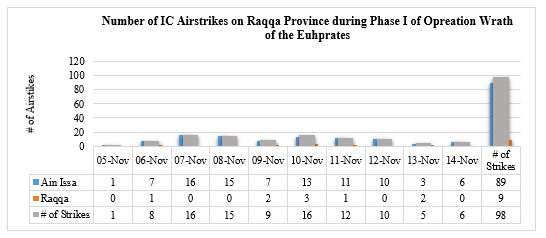
From its start, the operation focused on the rural areas south of Ain Issa, which are easy to take unlike residential areas. However, the situation was not so simple since ISIS depended on improvised explosive devices (IEDs), which were planted randomly around Ain Issa causing serious damage to the SDF. The presence of IEDs was the main reason for the heavy Coalition strike on areas where there were no ISIS forces present.
The second phase of Operation Wrath of the Euphrates started on December 10, 2016, aiming to take control of Raqqa’s western rural areas along the banks of the Euphrates River. The most significant development in this phase of the battle was the SDF’s announcement of new parties joining the operation:
- The Elite Forces of the Syrian Future Movement led by Ahmad Al Jarba after his deal with Movement for a Democratic Society (TEV-DEM).
- The Military Council of Deir Ezzor.
- Some Arab tribes from the area.
In the announcement came a confirmation by Jihan Sheikh Ahmed, a spokesperson for the Wrath of the Euphrates Operation, of successful coordination with the Coalition in the previous phase and the expectation of continued coordination.
The second phase of the operation lasted until January 16, 2017, during which 2,480 square kilometers were taken over from ISIS, as well as important places such as the historic Qalet Jaber.
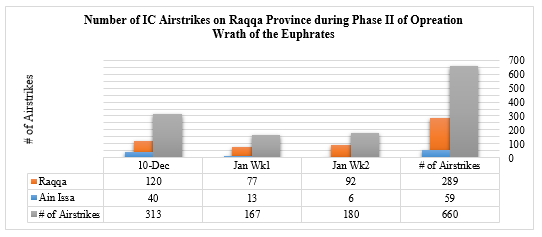
On February 4, 2017, the SDF announced the start of the third phase of Operation Euphrates Shield. This phase of the operation aimed to cut off lines of communication between Raqqa and Deir Ezzor and to make significant advances from the North and the West on ISIS’s self-declared capital.

In mid-March 2017, Coalition airstrikes intensified on Tabqa and the surrounding areas, reaching 125 strikes between March 17 and 26. On March 25, an offensive was launched to seize control of the 4 km-long Euphrates Dam in Tabqa. On March 26, the dam was struck by Coalition airstrikes making it non-operational.
Despite the heavy Coalition airstrikes, the YPG and its allies were unable to take the dam due to the large number of IEDs planted by ISIS. According to field interviews conducted by Omran Center, American troops landed in western rural Tabqa as YPG-led forces crossed the Euphrates River. An attack ensued on the Tabqa Military Airport from the South without striking the city itself.
On the evening of March 26, the YPG announced control over the military airport and immediately after—with oversight by American and French troops—the YPG started operations to take control of the rural parts of the city. By mid-April, the city was besieged and operations began to take the city with a significant uptick in Coalition airstrikes. Airstrikes on Tabqa city during the month of April 2017 reached 215 strikes, making Tabqa the most targeted city by the Coalition during that month, as shown below.
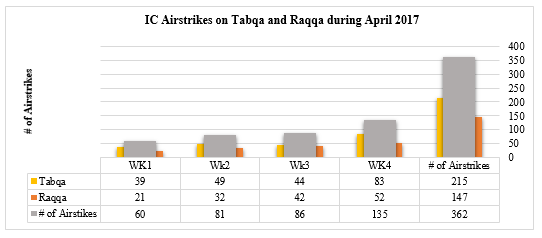
Forces involved in the Tabqa offensive: The Americans headed up the landing south of the Euphrates. French troops were present at Jabar on the other side of the river and were able to secure boat crossings for the YPG to the other side. Coalition forces wanted to take Tabqa Military Airport to make it a base for future operations and eventually for the complete siege of Tabqa. As for the YPG, its role was limited to protecting the backs of the Coalition forces and then moving in when the Coalition leaves.
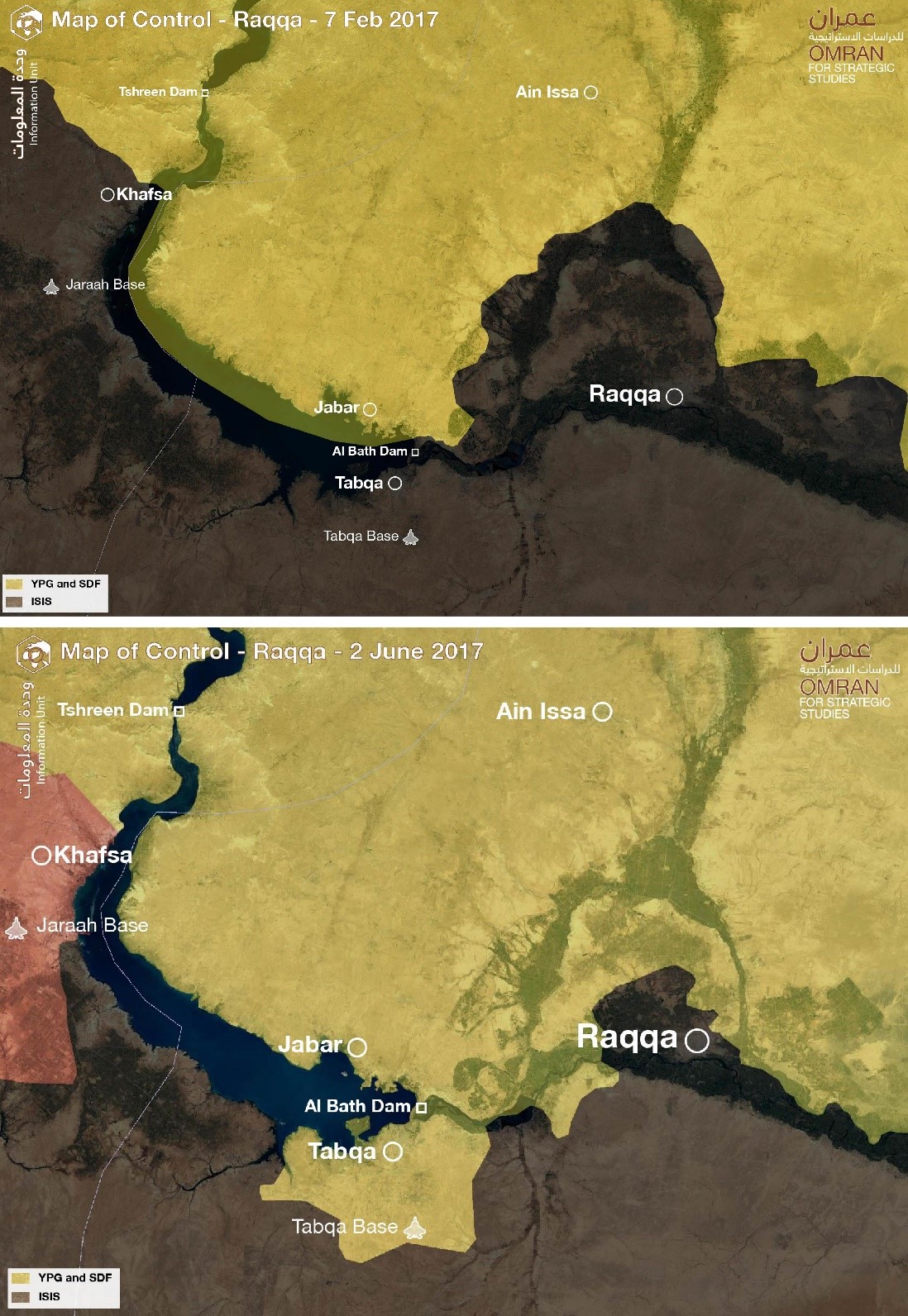
Map No. (1) Control and Influence of Raqqa and Tabqa, between 7 February 2017 and 2 June 2017
On April 13, the SDF announced the fourth phase of Operation Wrath of the Euphrates that aimed to take what remained of northern rural Raqqa and Jallab Valley, according to a statement released by the Wrath of the Euphrates operations room.([19])
Even though the SDF announced the fourth phase of Operation Wrath of the Euphrates, and previous phases achieved their stated goals, it was not able to take full control of Tabqa city until May 4, 2017. Furthermore, that only happened after making a deal with ISIS to let its fighters and their family members leave towards Deir Ezzor.([20])
Costs of the Battle (Infrastructure and Civilians):
Coalition strikes in September 2016 destroyed the remaining bridges that crossed the Euphrates River between the Iraqi border and eastern Raqqa. Additional raids destroyed the city's bridges on February 3, 2017. The Euphrates Dam was also damaged because of the clashes and now, with a damaged control room and the introduction of melting snow, the dam's status is questionable, with the water level increasing 10 meters since the beginning of the year.
The dam is now non-operational due to clashes between Kurdish fighters and ISIS, coupled with Coalition strikes. This has caused major concerns because if the dam breaks, the water could submerge more than one third of Syria and large parts of Iraq, reaching Ramadi.
Almost all of the hospitals in rural Raqqa are out of service. The only hospital remaining is operating at one fourth of its capacity even though there are approximately 200,000 civilians living there.([21])
On March 21, 2017, more than 200 civilians were killed and wounded in a Coalition strike on a school inhabited by displaced persons in the town of Mansoura in rural Raqqa.([22])
Again, on March 22, 2017, Coalition strikes committed another attack in Tabqa, west of Raqqa, targeting a bakery in a busy market killing at least 25 civilians and injuring more than 40 others.([23]) On April 22, 2017, another five civilians were killed and tens were injured in a Coalition airstrike on Tabqa.
In a mistaken strike by Coalition forces, 18 SDF fighters were killed south of Tabqa. The coalition released a statement explaining that the strike was conducted based on a request from one of its partners and the target was identified as an ISIS fighting position. The statement explained that the target was actually a front position of the SDF.([24])
Battle Scenarios
Even though the SDF is dominating the headlines and appears as the ideal force to liberate Raqqa, a number of factors indicate that there is more than one plausible scenario for the liberation of Raqqa. The issue is not determined solely by the force that will do the bulk of the fighting but also, who will administer the city after it is retaken, who will go after ISIS forces fleeing the city, and who will attack the last ISIS stronghold in Deir Ezzor, Syria.
The factors influencing the drawing up of possible battle scenarios are as follows:
- The SDF is unable to carry out the fight alone, evidenced by the need for direct participation from Coalition ground forces in critical positions and the increased number of American troops in Syria. Furthermore, the SDF has been ineffective in identifying enemy positions resulting in a large number of civilian deaths and even the deaths of 18 of its own fighters.
- Raqqa’s geographical positioning is quite difficult to deal with. It is open to Hassaka to the northeast and Deir Ezzor to the south, which is open to Iraq’s southeast. To the west, Raqqa is open to Hama and Homs, and to the north, Raqqa is open to Turkey. This requires a complicated coordination effort between local and international forces that must participate to make any final offensive effective.
- There is an ongoing struggle over ISIS’ legacy and the areas that it will leave behind that cover a significant geographic area. This issue is directly linked to the shaping of a political solution in Syria, which has put the battle of Raqqa under the pressures of conflicting interests of local, regional, and international actors involved in Syria.
- The Trump administration found itself in a predicament when it realized that the Obama administration’s Raqqa plan depended too heavily on arming and supporting Kurdish forces. On the contrary, the Trump administration adopted a policy of improving ties with Turkey and working closely with Russia to reach a political settlement to the Syrian crisis.
Given these factors, it is possible to project the following four scenarios for the battle of Raqqa:
First Scenario
The U.S. would continue to exclusively depend on the YPG and make serious attempts to take advantage of the Arab forces that are currently an inactive part of the SDF. This would balance out the influence of the PYD in the SDF. After Raqqa is liberated, it would be handed to a local council that represents the local population, as is being planned for now. This scenario seems more likely if we look at the increasing number of American troops in Syria. There are also 1,000 American Special Forces deployed in Kuwait on standby ready to be called in to support operations in Syria or Iraq. President Trump has also given the army the authority to determine appropriate troop levels in both Iraq and Syria.([25]) In this scenario, the U.S. would be able to conduct a successful operation to take Raqqa but with a significant footprint, including direct combat and an extended period. Moreover, the political issues would remain unresolved, especially with respect to Turkey. These unresolved political issues could heighten tensions between Turkey and the U.S. after the battle for Raqqa, especially since Turkey insists that the SDF refrain from taking control of any other territory and that current SDF-controlled territory be disconnected. Increased tensions with the U.S. may lead to a solution in this scenario that is something similar to what happened in Manbij.([26]) Moscow is hoping that it can take advantage of Turkish-American tensions in order to push the participation of regime forces as a legitimate option.
Second Scenario
The U.S. and Turkey would increase their coordination in Syria while pushing the PYD forces farther away. This would happen according to one of two Turkish plans. The first is that Turkish forces enter Syria towards Raqqa from Tal Abyad and the SDF opens a 25-km corridor for them. This would mean the PYD loses control of Tal Abyad and cuts off unobstructed access between Qamishli and Ain Arab (Kobani), which is unlikely. The other option is for Turkish forces to enter from Al Bab, which would mean either attacking regime forces or coordinating with them to secure a corridor access to Raqqa. It is unclear until now if the Trump administration is willing to completely give up its coordination with the SDF. In addition, the option of having Turkish-backed Arab forces fighting alongside the SDF is unlikely since both Turkey and the SDF reject such a proposal. Turkey will not participate in the battle if the other party includes PYD forces.
Third Scenario
The Americans and Russians would reach an agreement on the framework of a solution in Syria. This would include neutralizing Turkey and enabling the participation of regime forces alongside the YPG. This scenario would be welcomed by the regime. This scenario could become more likely because of the regime’s advances in eastern rural Aleppo reaching the administrative border of Raqqa Province (Ithraya-Khanaser). The regime has also reinforced its presence in Ithraya on the way to Tabqa, as well as in Palmyra, which is a critical position on the road between Palmyra and Raqqa. The regime has also been making attempts to increase its control of more positions in the desert by attacking “Usood al Sharqiyeh” forces in recent days.([27]) The regime also controls critical positions in Deir Ezzor, especially in the western rural areas congruent with Raqqa Province. This includes the Deir Ezzor Military Airport in the eastern part of the province, which extends to the Iraqi border. Thus, the regime puts the Coalition in a position where it has no choice but to coordinate with regime forces, either in the battle for Raqqa or in future operations.
Fourth Scenario
The results of the last Astana meeting to create four de-conflicted zones could be a premise for a fourth scenario in which the U.S. is more open to the participation of all interested parties from Astana in the battle for Raqqa and what comes after. This would include roles for the SDF, regime forces, and opposition forces backed by Turkey. American and Russian oversight would ensure effective implementation of the participating forces and prevent any infighting among them. The de-confliction zones proposal is the strongest evidence that such a scenario may be carried out. The de-confliction zones would essentially mean a truce between regime and opposition forces with well-defined borders in order for the parties to focus their efforts more closely on fighting ISIS. Turkey and Russia responded positively to the last Astana meeting, which followed a meeting between the presidents of Turkey and Russia, indicating that there are some preexisting agreements about Turkey’s participation in the battle for Raqqa. Furthermore, the American approval of the de-confliction zones indicates a possible three-way understanding about the battle for Raqqa. Another positive development is Russia’s reopening lines of communication with the U.S. regarding sharing and coordinating Syria’s air space. This was surprising given the deadly strikes on the Sheirat air base. Further clarification on this possible three-way understanding on the battle for Raqqa is expected following the meeting between U.S. President Donald Trump and Turkish President Recep Tayyip Erdogan in Washington, D.C. on [insert date].
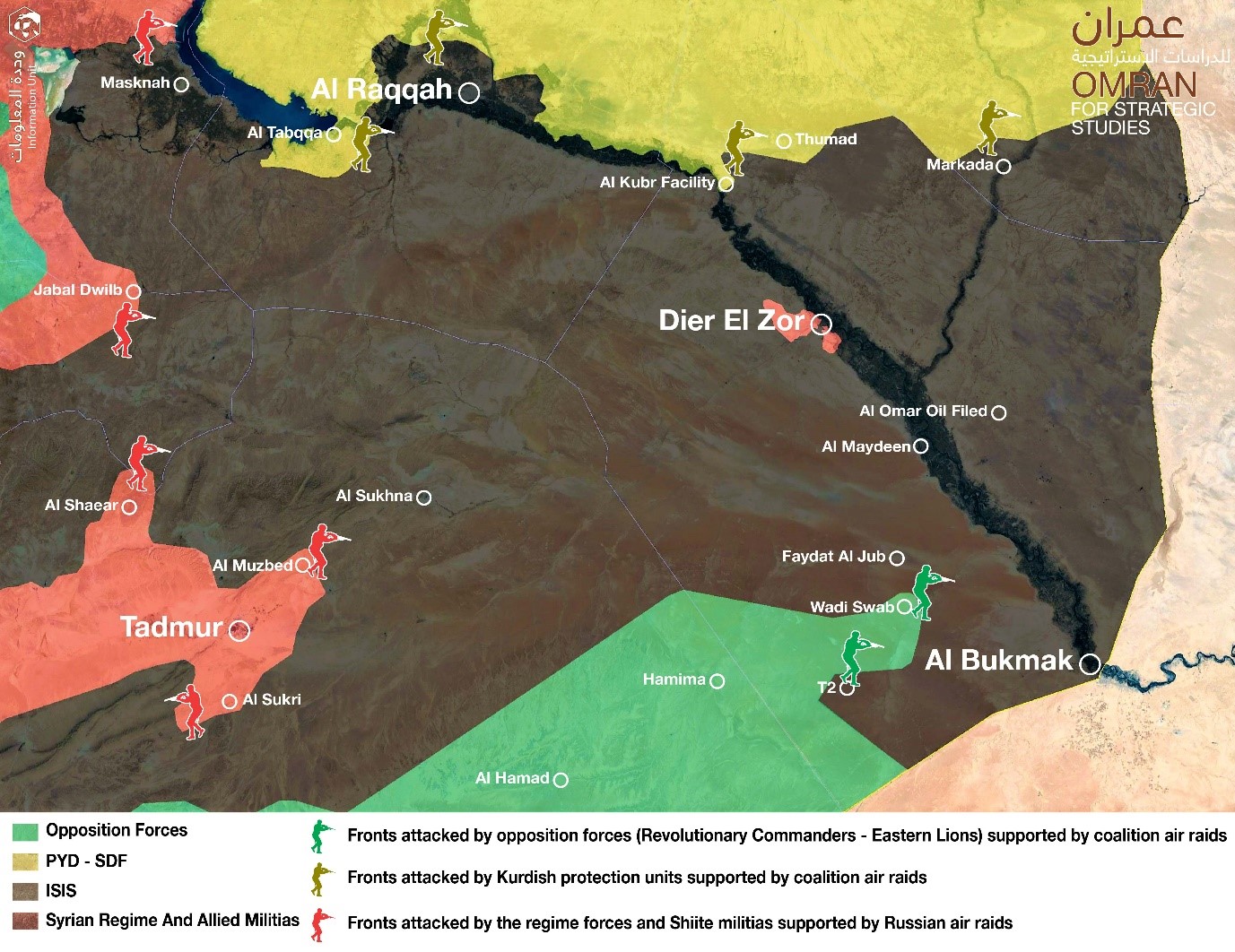
Map No. (2) Control and Influence of Eastern Syria – May 7, 2017
Conclusion
The presence of American forces in Syria joining the fight against ISIS is a significant change in the Syrian arena, making the situation more complicated and the interests of the various parties more contradictory. In the meantime, the U.S. continues to take advantage of these contradictory interests. Therefore, the most important contribution of the American entry into Syria was undermining the post-Aleppo status quo established by Russia in an attempt to create a new climate that is more consistent with an American policy that is more involved in the Middle East. These new understandings are still unclear and will not be completely understood until after the defeat of ISIS. The battle for Raqqa and what comes after are the apex of these understandings, especially the shape of a future Syria that regional and international actors will decide.
([1]) Front lines defenses were shored up at the eastern edge of Operation Euphrates Shield territory with regime, Russian, and US forces creating a buffer preventing any further Turkish backed offensive.
([3]) Fabrince Balance, The Battle for al-Bab Is Bringing U.S.-Turkish Tensions to a Head, The Washington Institute, 2017, https://goo.gl/Q5zGrg
([4]) Turkey announces the end of Operation Euphrates Shield, Arabic, Aljazeera Net, https://goo.gl/JvGtqT
([5]) “Eastern Shield Army”, A new formation to face three powers in Syria’s east, Enab Baladi News, Arabic, https://goo.gl/y4zVWx
([6]) Turkey’s plans to liberate Syria’s Raqqa, Turkey Now, Arabic, https://goo.gl/cmJr9X
([7]) American, Russian, Turkish coordination in Syria, Arabic, Aljazeera Net, https://goo.gl/O7cAC6
([8]) Moscow offers coordination with America in Syria, Al Hayat, https://goo.gl/mDCKb1
([9]) Front lines defenses were shored up at the eastern edge of Operation Euphrates Shield territory with regime, Russian, and US forces creating a buffer preventing any further Turkish backed offensive.
([10]) Safinaz Muhammad Ahmad, “Manbij and Raqqa..International and regional interventions and the new maps of influence in Syria”, Al Ahram for Strategic Studies, https://goo.gl/PyVtoS
([11]) Ibrahim Humeidi, Moscow’s surprise between Manbij and al Bab: Tempting Washington and marginalizing Ankara, Al Hayat, https://goo.gl/VnGkKn
([12]) Larijani: US intervention in Syria is not in its favor .. The presence of the Marines was not in coordination with Tehran .. We do not aim to achieve special interests in Syria, Rai Al Youm, https://goo.gl/PRk0SA
([15]) "Marines" in Syria to accelerate the battle of Raqqa ... and "reassure" Turkey, Al Hayat, https://goo.gl/UELPQg
([17]) PKK is the Kurdistan Workers Party
([18]) After abandoning Obama's plan .. Trump is looking for his way to Raqqa, Russia Today Arabic, https://goo.gl/jvyX8p
([19]) The fourth phase of “Wrath of the Euphrates”: Trying to reach Raqqa’s border, The New Arab, https://goo.gl/JTHxLS
([20]) Daesh withdraws from Tabqa under agreement with SDF, The New Arab, https://goo.gl/3cZcD3
([21]) Raqqa, Between Coalition massacres and preparing for what is after Daesh, Enab Baladi, https://goo.gl/OiQTJ0
([22]) A new massacre by the international coalition in Mansoura in rural Raqqa, Zaman Alwasl, https://goo.gl/6VUbGZ
([23]) The international coalition commits a massacre in Tabqa, Raqqa Post, https://goo.gl/pp2wLv
([25]) Trump gives the Pentagon the power to determine troop levels in Iraq and Syria, Reuters, https://goo.gl/7Er9oO
([26]) Front lines defenses were shored up at the eastern edge of Operation Euphrates Shield territory with regime, Russian, and US forces creating a buffer preventing any further Turkish backed offensive.
([27]) Lions of the East: The regime advances in rural eastern Sweida, MicroSyria, https://goo.gl/zB8cIV

